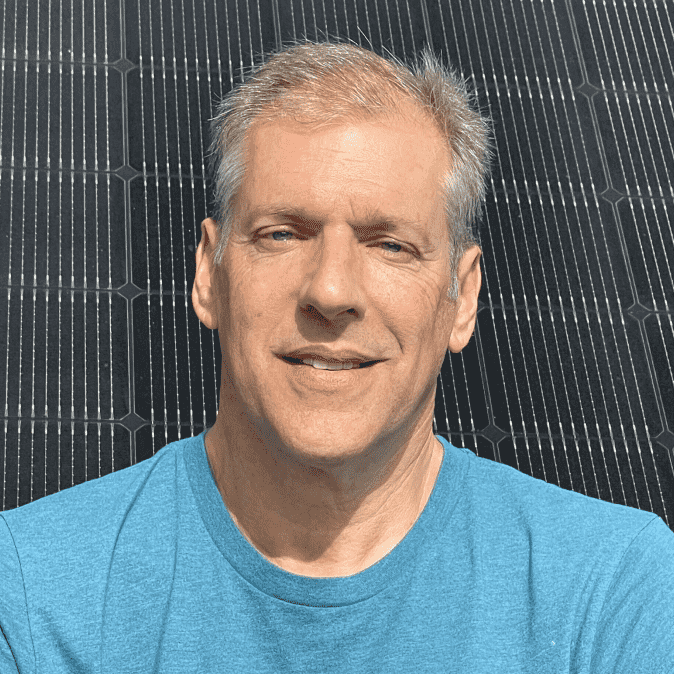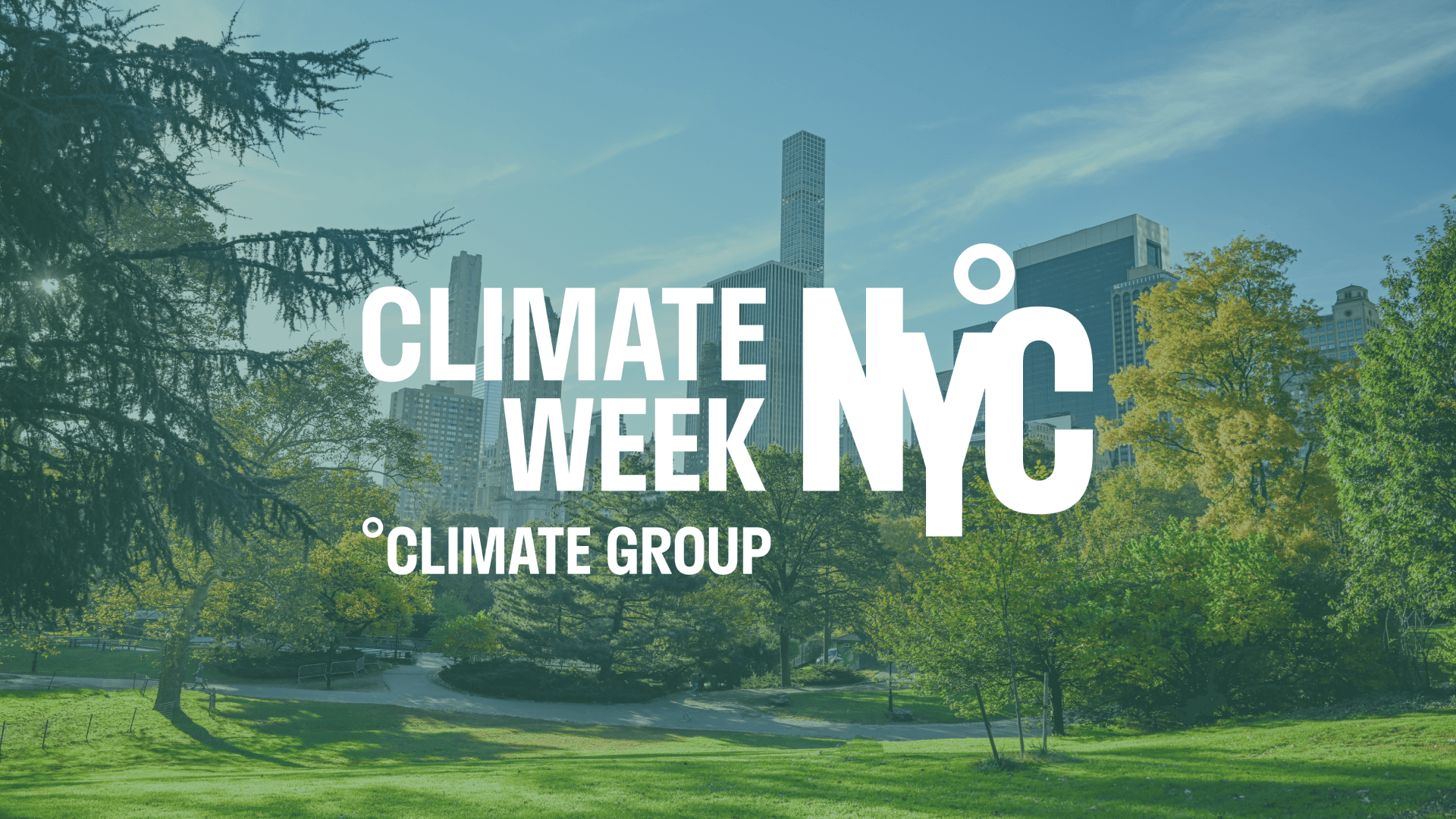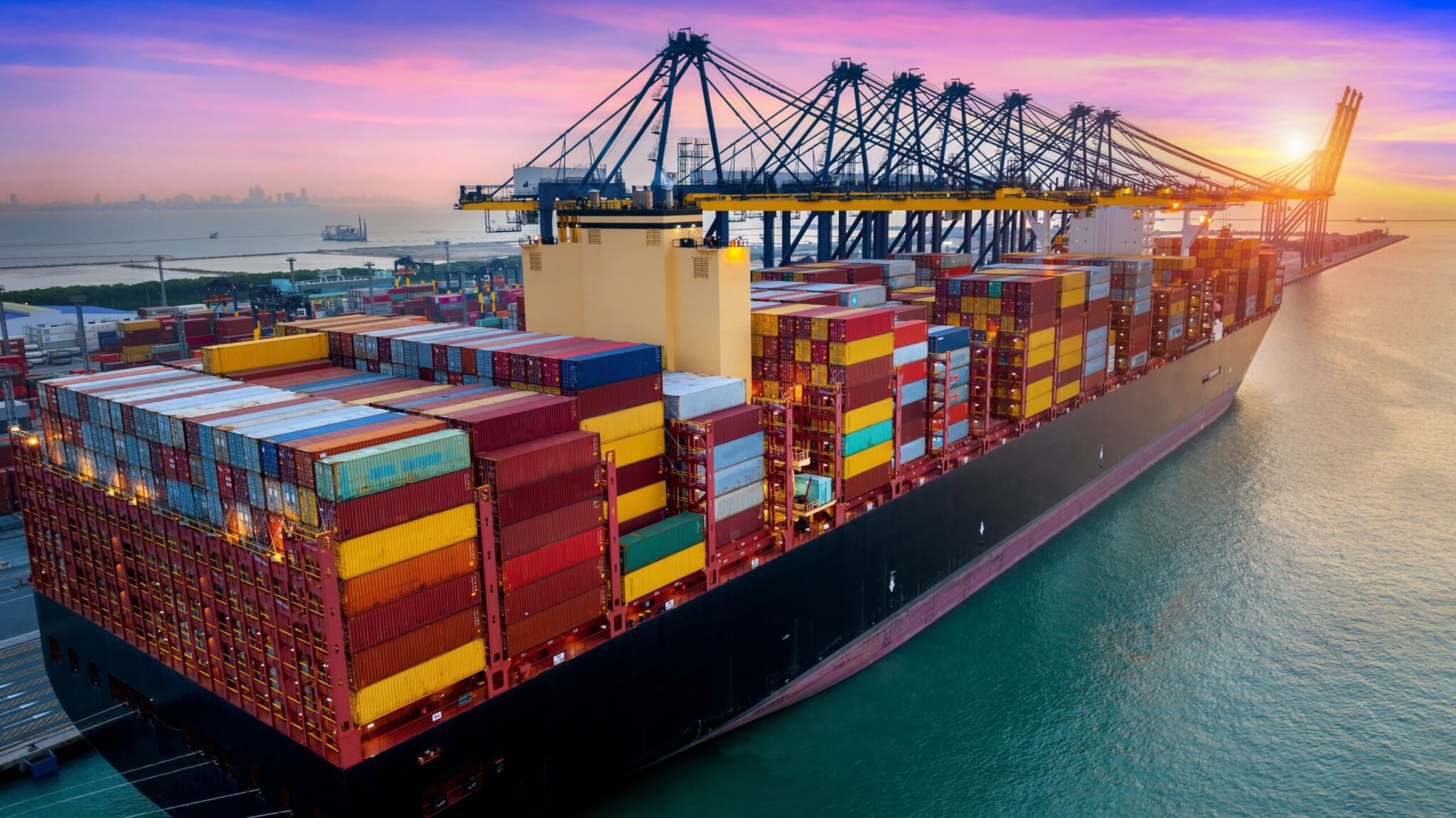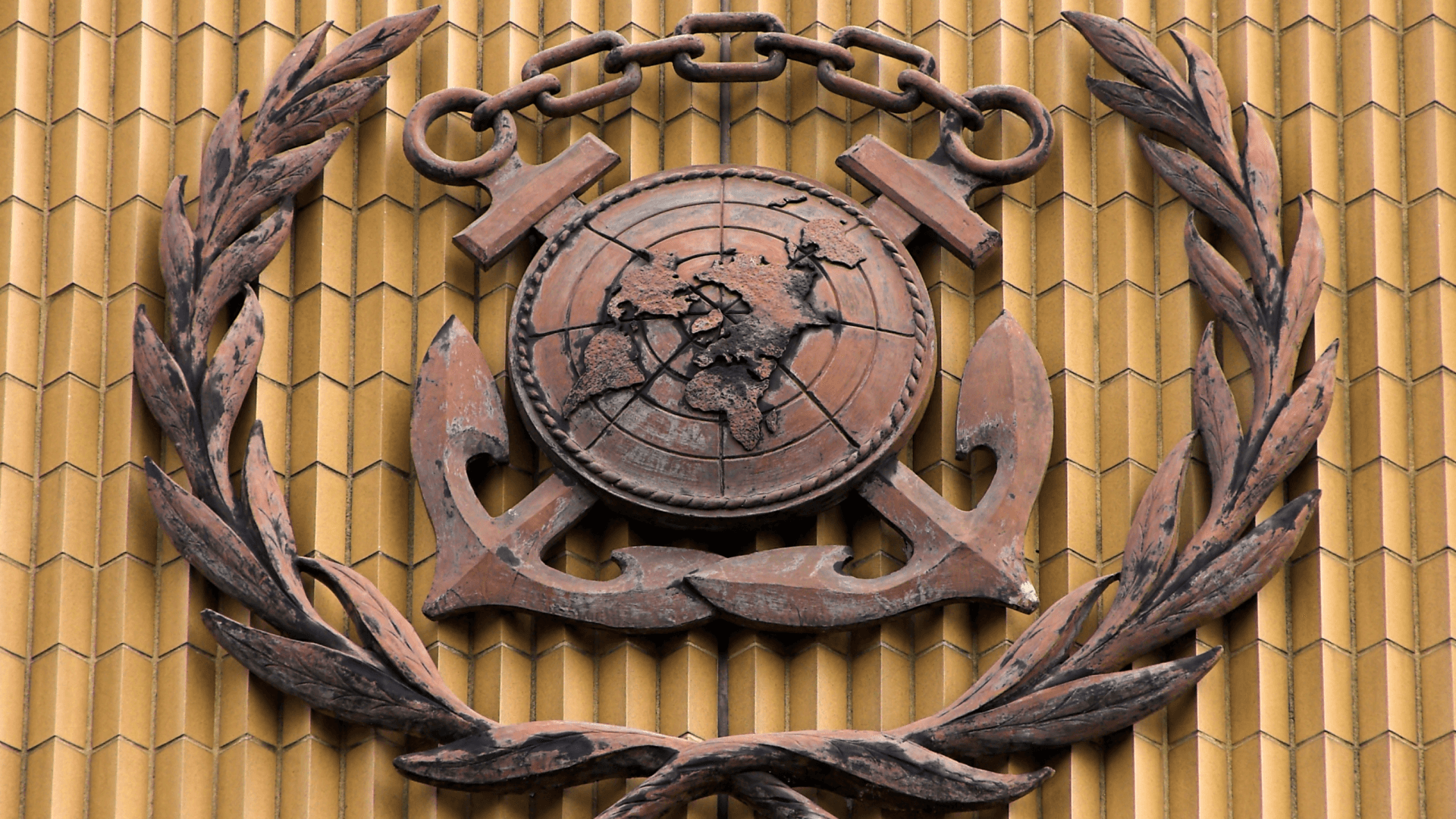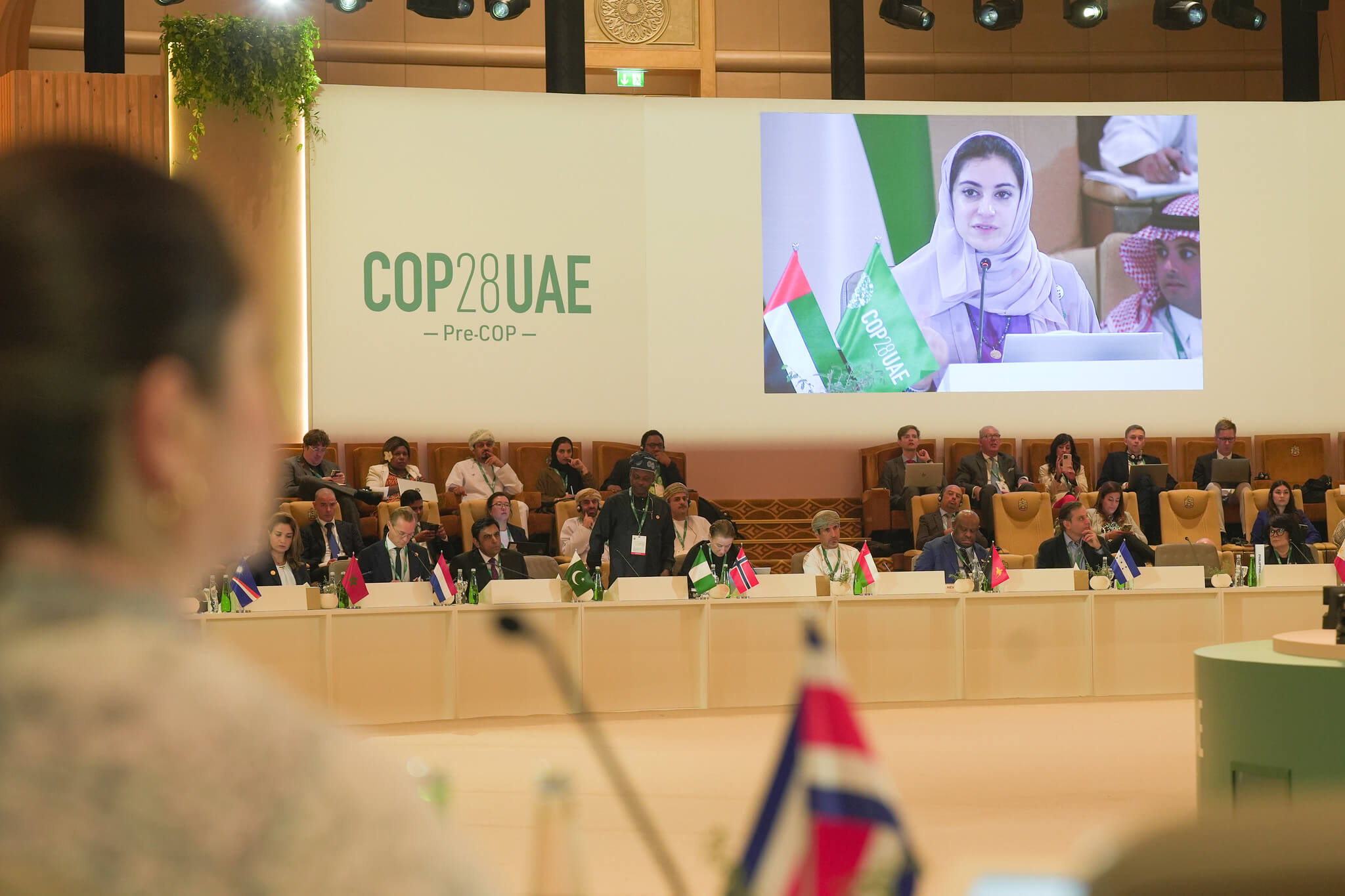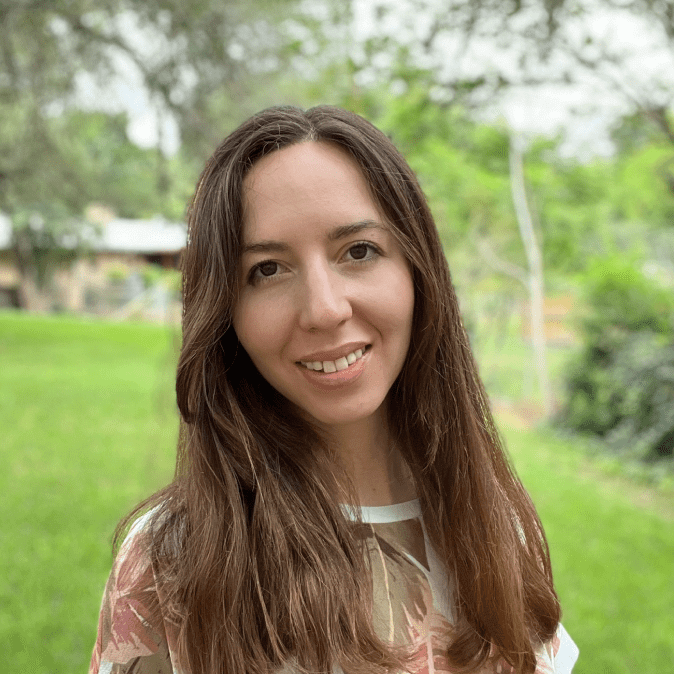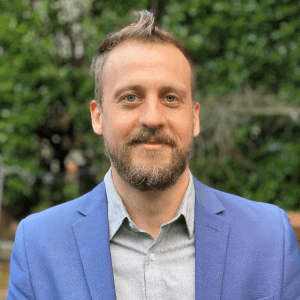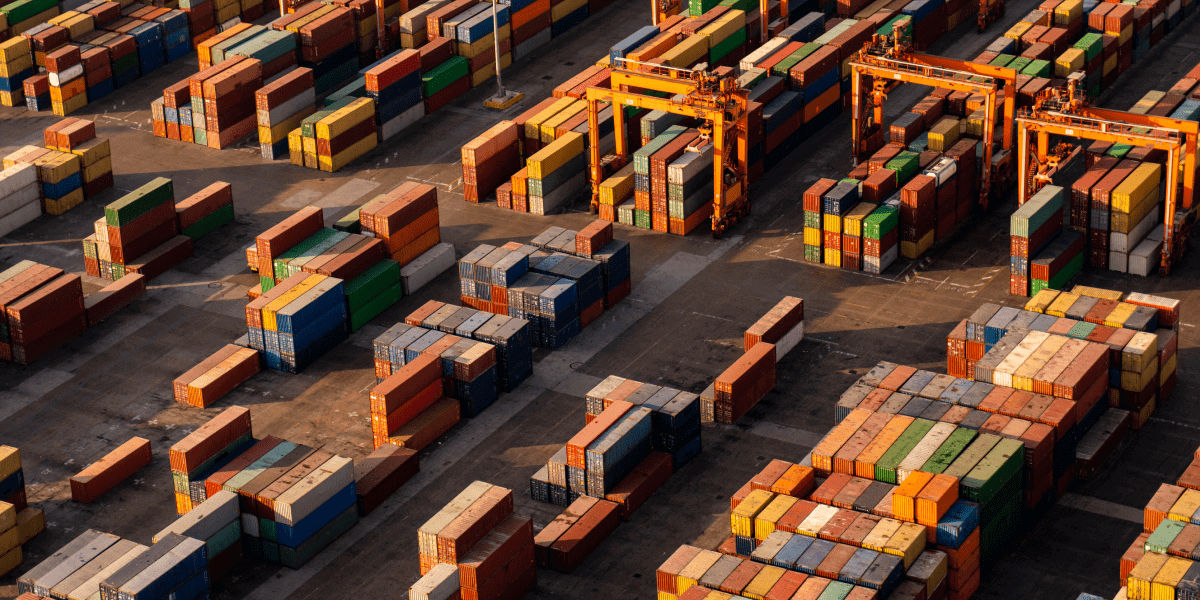
Achieving carbon neutrality requires deploying renewable energy at unprecedented speed and scale, a process that relies on an efficient global clean energy supply chain. Based on the IEA’s Net Zero by 2050 report, solar and wind energy deployment must reach 20 and 15 times their 2020 levels by 2050, respectively, to bring down global energy-related carbon emissions to net zero. The global supply chains for solar and wind, intertwined with minerals for the energy transition and storage technologies, play a pivotal role in the success of this transition.
Today, however, there are multiple threats to the stability of the global clean energy supply chains. The Covid-19 pandemic has revealed the vulnerability of global supply chains, disrupting manufacturing, transportation, and distribution networks worldwide. Geopolitical tensions and trade conflicts add another layer of complexity. The trade war has disrupted the free flow of capital, products, and even talent — essential components of the supply chain. Additionally, climate-induced extreme weather events and natural disasters pose physical threats to the infrastructure of the supply chain, affecting both production and distribution.
The unequal distribution of costs and benefits along the supply chain raises ethical and socio-economic concerns, sometimes leading to countries breaking from the supply chain. While some regions benefit economically from the growth of the renewable energy sector, other regions bear disproportionate environmental and social burdens, particularly in Africa, Southeast Asia, and South America. The extraction of minerals for the energy transition essential for battery manufacturing often occurs in these regions, leading to environmental degradation, exploitation of local communities, and insufficient sharing of economic benefits. Deep seabed mining, promoted by some, presents an added layer of ecosystem risks.
Despite these challenges, the benefits of a global supply chain are massive. An efficient and resilient supply chain is crucial for achieving continued cost reductions in solar, wind, and storage technologies — a key factor in scaling up deployment. A paper published in Nature shows solar PV costs could be 20% to 30% higher in 2030 if countries move from a global supply chain to domestic manufacturing. The interconnectedness of these technologies, facilitated by a global supply chain, not only aids in cost reduction but also plays a pivotal role in carbon mitigation, pollution reduction, and overall improvement of human health. A recent paper published in Communications Earth & Environment found that the coordination of global solar manufacturing in low-carbon regions and prioritized installation in carbon-intensive regions could achieve 97.5 gigatons less net carbon between 2020 to 2060. These benefits underscore the importance of preserving and strengthening the global supply chain, even as we navigate the challenges it presents.
In addressing these challenges and maximizing the benefits, there is a pressing need for a commonly agreed framework for a just, resilient, and sustainable clean energy supply chain. Such a framework would bring together relevant parties from all countries and a range of sectors, fostering understanding and collaboration. This collaborative approach is essential for advancing solutions that continue to harness the benefits of a global supply chain while effectively addressing concerns about the associated risks and uncertainties.
A just, resilient, and sustainable framework for the clean energy supply chain needs to consider the specific challenges faced by different regions, especially in Africa, Southeast Asia, and South America. In these regions, the risks from supply chain disruptions are exacerbated by pre-existing socio-economic vulnerabilities. The pandemic has highlighted the need for robust public health infrastructure, social safety nets, and resilient economic systems. Geopolitical tensions can disproportionately affect emerging economies, disrupting their economic development and access to crucial clean technologies. Climate events can have severe consequences in regions that are already overburdened with the impacts of climate change, leading to a compounding of challenges.
A multi-faceted approach
Addressing these challenges requires a multi-faceted approach that combines international cooperation, targeted policy interventions, and technological innovation.
Firstly, international cooperation is essential to facilitate a clean energy supply chain. Efforts should be made to de-escalate trade tensions and foster collaboration between countries. Additionally, a global framework for the ethical and sustainable mining of critical minerals is crucial. This framework should ensure that mineral extraction respects environmental standards, labor conditions, and the well-being of local communities.
Secondly, policy interventions at both national and international levels are vital to create a just, resilient, and sustainable clean energy supply chain. Governments need to implement policies that promote transparency, fairness, and inclusivity in the renewable energy sector. This includes establishing clear guidelines for ethical supply chain practices, incentivizing sustainable extraction of minerals, and ensuring that the benefits of the renewable energy transition are shared equitably. International organizations can play a pivotal role in facilitating dialogue, setting standards, and providing support for emerging economies to strengthen their renewable energy infrastructure and institutions.
Thirdly, technological innovation is key to mitigating risks associated with the clean energy supply chain. Research and development efforts should focus on alternative materials that reduce dependence on minerals for the energy transition while increasing recycling technologies to recover valuable components from end-of-life solar panels, wind turbines, and battery packs. Investing in innovative solutions will not only address the current challenges but also future-proof the clean energy supply chain against emerging risks.
In crafting a just, resilient, and sustainable framework, it is crucial to consider the social and environmental impact of the supply chain at every stage. This includes the extraction of raw materials, manufacturing processes, transportation, distribution, installation, operation, and end-of-life disposal. Transparency and standards can help ensure accountability and enable consumers, investors, and policymakers to make informed decisions that align with ethical and sustainability considerations.
Furthermore, a just framework should prioritize the involvement of local communities and workers in the clean energy supply chain — fostering skill development, creating job opportunities, and ensuring fair wages and working conditions. Community engagement should be a cornerstone of supply chain and clean energy investments and projects, allowing local residents to actively participate in decision-making processes and share the benefits of renewable energy development.
The global clean energy supply chain stands at a critical intersection of immense benefits and pressing challenges. While it is a linchpin for achieving global climate goals, its vulnerabilities to disruptions, geopolitical tensions, and unequal distribution of costs and benefits cannot be ignored. Creating a just, resilient, and sustainable framework for the clean energy supply chain is not only an ethical imperative but also a pragmatic necessity. By doing so, we can ensure that the benefits of renewable energy are realized globally, leaving no one behind in the clean energy transition to achieve climate goals.
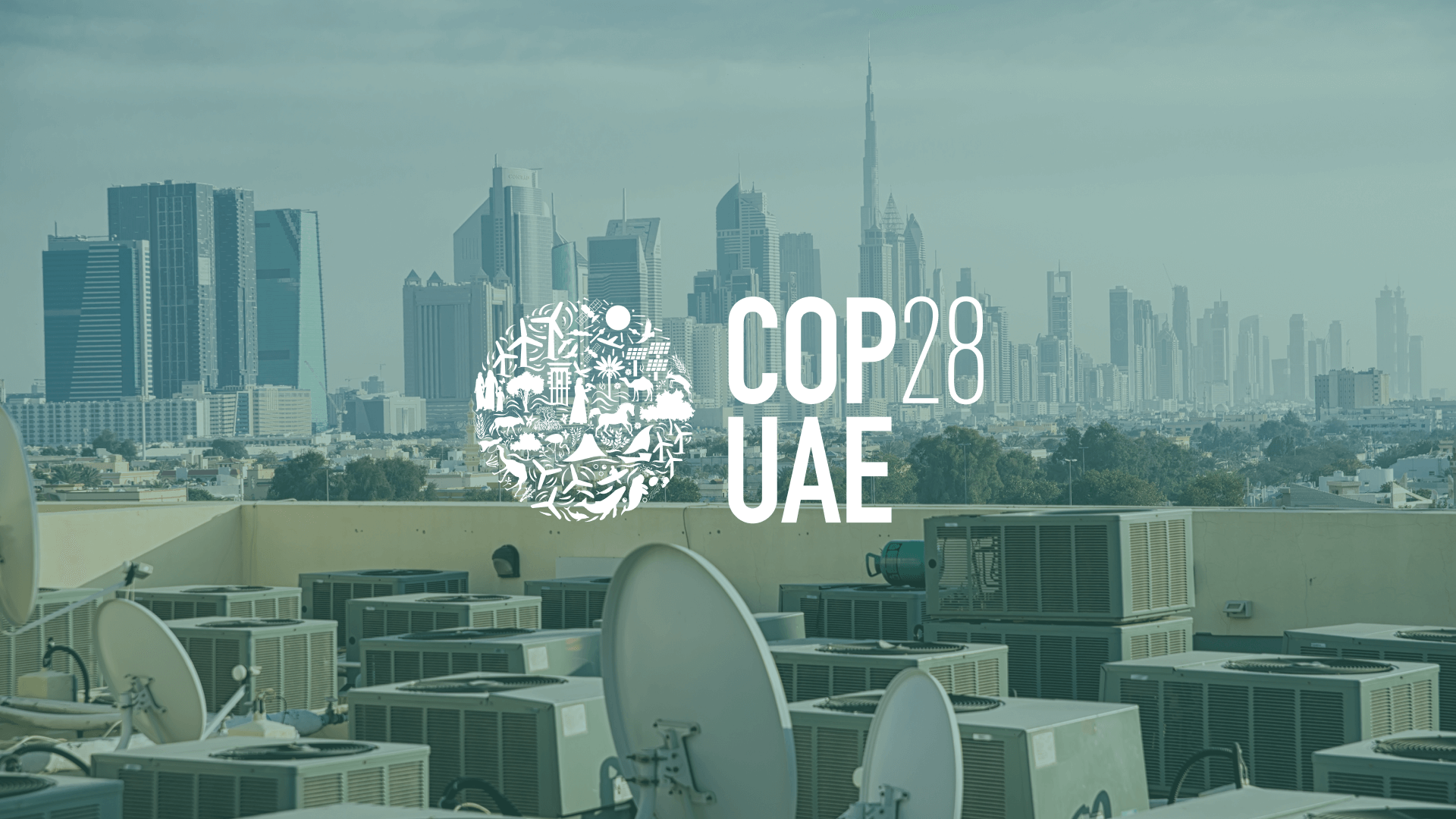
Follow ClimateWorks and our global network of partners during the COP28 conference.
COP28 is one of the most significant climate accountability moments to date. In Dubai, world leaders must respond to the Global Stocktake with bold climate action that protects people and the planet.
Climate impacts are here and getting worse every year. The Global Stocktake report findings say that we are way off track in tackling climate change. Already, the planet is heating up faster than predicted, creating devastating harm for millions of people globally and deepening existing socioeconomic inequalities.
Despite so much gloom, positive changes are happening. We are seeing encouraging progress across sectors and geographies at a promising pace. This includes renewable energy capacity achieving sharp increases, EVs surging to market dominance, and heat pumps witnessing double-digit growth.
Rapid action to address climate change is not only possible, it’s already underway — but we have to pick up the pace. We must bring positive tipping points forward and invest in them like we want them to win. Now is the time for all of us — governments, businesses, philanthropy, and civil society — to raise our ambition, accelerate our efforts, and work together to achieve a pathway to a 1.5° C future.
That is why ClimateWorks will be on the ground in Dubai — to strengthen strategic partnerships across sectors and build upon opportunities where philanthropy can catalyze the transformation we need today.
Whether you are attending COP28 in person or joining online, here are some events we recommend.
This is a live document and will be updated as new information becomes available.
ClimateWorks on the ground
Bottom-up approach of regional non-state actors toward updating NDCs in post-GST
December 1, 6:30-8:00 pm GST
Blue Zone, SE Room 8
ClimateWorks’ Josefina Cobian speaking
The independent Global Stocktake (iGST) Regional Hubs in Southeast Asia and West Africa will explore the ways in which non-state and state actors can effectively align their efforts during the post-stage of the first GST to have more ambitious climate action at the next round of NDCs.
Tripling renewables: The role of innovative finance solutions and experience from emerging markets
December 1, 10:00-11:15 am GST
Blue Zone
ClimateWorks’ Jide Ikeako speaking
Decoding G20’s green development pact
December 1, 2:30-4:00 pm GST
ClimateWorks’ Helen Mountford speaking
The session will discuss India’s G20 Presidency outcomes, the role of G20 nations in the Green Development Pact, and propose solutions in anticipation of the Global Stocktake at COP28, highlighting the significance of international cooperation in addressing environmental challenges and promoting sustainable development.
Circular economy: A path to climate solutions and sustainable development
December 2, 10:30-11:45 am GST
SDG Pavilion, Blue Zone
ClimateWorks’ Helen Mountford or Xiaohua Zhang speaking
Hosted by the UN SDG Pavilion with ClimateWorks Foundation and the National Centre for Climate Change Strategy and International Cooperation, China
Philanthropy’s role in adaptation: Advancing collective action
December 2, 11:15 am–12:15 pm GST
Business and Philanthropy Forum Roundtable, Expo City Dubai
ClimateWorks’ Helen Mountford is leading the discussion.
Co-hosted by ClimateWorks and the Bill & Melinda Gates Foundation, this roundtable will bring together a diverse group of philanthropies interested in early-stage strategy development for investing in adaptation.
Ocean alkalinity enhancement: A guide to responsible, transparent, and inclusive research
December 2, 12:00-1:00 pm GST
Ocean Pavilion, Blue Zone
Ocean alkalinity enhancement (OAE) is a marine CDR approach actively studied by publicly and philanthropically funded research projects and start-ups. This has created an urgent need to learn if and how OAE can work at scale before mid-century, to identify potential impacts and ensure that OAE research is responsible, transparent, and inclusive. This panel will present the main findings of the “Guide to Best Practices in OAE Research” that offers guidance to advance knowledge on scientific aspects, legal and social considerations, and Monitoring, Reporting and Verification.
First movers in action: Decarbonizing heavy industry and shaping the future
December 2, 2:00–3:15 pm GST
Business and Philanthropy Forum Theater, Expo City Dubai
ClimateWorks’ Helen Mountford speaking
Two years after the First Movers Coalition (FMC) launch, this session will feature major announcements on the progress that have been made and showcase important new features of the FMC program. Join key players in hard-to-abate industries to discuss the steps needed to achieve FMC’s ambitious near-zero targets by 2030.
Philanthropies and adaptation: From ambition to action
December 2, 3:00-4:00 pm GST
Resilience Hub
ClimateWorks’ Jess S. Brown speaking
We will hear from philanthropies on their commitment to joint learning, coordination, strategy development, and increased investment to strengthen resilience and reduce climate vulnerability through increased support for climate adaptation.
Donor Co-Creation Session on Carbon Finance
December 2, 5:15-7:00 pm GST
SDG7 Global South Pavilion, Blue Zone
ClimateWorks’ Helen Mountford speaking
Philanthropy Asia Alliance and World Economic Forum on climate philanthropy
December 3, 1:00-2:00 pm GST
Blue Zone
ClimateWorks’ Helen Mountford speaking
Unleash the potential of solar-plus solutions in Africa: Innovative collaboration opportunities between China and Africa
December 4, 9:00-10:15 am GST
SDG Pavilion, Blue Zone
ClimateWorks’ Jide Ikeako speaking
Cool Coalition: Financing action on cooling
December 4, 9:30-10:30 am GST
Montreal Protocol Pavilion
ClimateWorks’ Noah Horowitz speaking
The Global Stocktake: How can we ensure this is the decade of global climate action?
December 4, 10:00-10:40 am GST
Sustainable Innovation Forum, Climate Action Innovation Zone
ClimateWorks’ Helen Mountford speaking
The Paris agreement saw 196 parties legally commit to global climate action in a bid to keep global warming to 1.5 degrees. The culmination of the Global Stocktake (GST) at COP28 will enable all stakeholders to identify the gaps in their emissions goals and find the optimum pathways to accomplishing these commitments. We will require unprecedented multi-sector collaboration to make this the turning point for climate action in this critical decade.
Circular economy’s role in promoting carbon reduction practice
December 4, 10:45 am-12:00 pm GST
China Pavilion, Blue Zone
ClimateWorks’ Xiaohua Zhang speaking
Global collaboration for innovation on sustainable cooling: Solutions for market transformation
December 4, 11:30 am-1:00 pm GST
SE Room 8, Blue Zone
ClimateWorks’ Noah Horowitz speaking
Press Conference – Global Cooling Stocktake and Pledge
December 5, 11:30 am-12:00 pm GST
Media Zone UNFCCC
Energy Foundation China international philanthropy roundtable
December 4, 2:45-4:00 pm GST
China Pavilion, Green Zone
ClimateWorks’ Helen Mountford speaking
Global Stocktake Event
December 4, 5:30-6:30 pm GST
WWF Pavilion
ClimateWorks’ Helen Mountford moderating
December 4, 5:30-7:00 pm GST
The Palm Majlis Room, Marriott Resort Palm Jumeirah
The Paris Agreement goals are still within reach, but there is an urgent need for bold clean energy policies to drive scaled investment and deployment. The Crux Alliance, Drive Electric Campaign, and ReNew2030 are collaborating globally to share the crucial know-how, technical expertise, and invaluable lessons learned about powerful policies and effective implementation.
Climate Resilience for All launch
December 4, 7:00 pm GST
Resilience Hub
ClimateWorks’ Noah Horowitz speaking
This is the launch event for Climate Resilience for All, a gender-focused climate adaptation nonprofit dedicated to the protection of people and livelihoods from extreme heat and all its impacts. The organization will work to help deliver tangible results and build trusted partnerships that help people now — and spur systemic change that brings a climate-resilient future to all.
How philanthropy can catalyze meaningful climate action
December 5, 9:30-10:15 am GST
Climate Action Innovation Zone
ClimateWorks’ Helen Mountford speaking
How can philanthropy go beyond funding interventions at the program level to matching the urgency, scale, and complexity of climate change? Models are starting to emerge. This panel brings philanthropy leaders together to discuss how funders are maximizing their impact, from supporting early-stage ideas that may be seen as too risky for traditional funders, to catalysing larger amounts of financing to sectors that might otherwise fail to mobilize sufficient resources.
Scaling up renewable energy manufacturing in Global South through enhanced south-south collaboration
December 5, 1:15-2:15 pm GST
SDG 7 Pavilion, Blue Zone
ClimateWorks’ Helen Mountford speaking
PV industry’s sustainable development in China
December 5, 4:00-5:30 pm GST
China Pavilion, Green Zone
ClimateWorks’ Xiaohua Zhang speaking
UNFCCC side event: Banking on climate — Going beyond climate finance
December 5, 4:45-6:15 pm GST
Room 5, Blue Zone
ClimateWorks’ Jwala Rambarran speaking
RACC Ambition Raising Panel: Raising ambition through a whole-of-society approach in the context of international cooperation
December 6, 10:30 am-12:00 pm GST
B7-88, Blue Zone
ClimateWorks’ Helen Mountford moderating
Sustainable food systems future
December 6, 1:15-2:45 pm GST
SE Room 8, Blue Zone
ClimateWorks’ Soojin Kim speaking
Get ready to be part of a transformative dialogue and contribute to a more sustainable and resilient food future! Contribute to real-time word cloud polls, hear insights from diverse experts on agriculture, nutrition, sustainability, and technology, and engage in discussions to explore innovative solutions for sustainable food systems. Your voice matters in this collaborative effort.
Advancing energy equity transition, amplifying enterprise and market leadership, accelerating clean technology innovation
December 6, 1:30-2:40 pm GST
China Center, Dubai Expo City
ClimateWorks’ Helen Mountford speaking
High-level forum on south-south cooperation on climate change: Ministerial forum
December 8, 9:00-12:00 pm GST
China Pavilion, Blue Zone
ClimateWorks’ Xiaohua Zhang speaking
Enterprise forum for China-Africa cooperation on renewable energy development
December 8, 2:00-3:15 pm GST
Solar+ Pavilion, Blue Zone
ClimateWorks’ Xiaohua Zhang speaking
Strengthen international industry chain cooperation and accelerate energy transition
December 9, 3:00-4:30 pm GST
SE Room 9
ClimateWorks’ Xiaohua Zhang speaking
Turning the Global Stocktake into Action on the Ground
December 9, 4:45-6:15 pm GST
SE Room 1, Blue Zone
Official ClimateWorks side event at COP28
At COP28, negotiators must deliver a rapid response plan to the Global Stocktake that decarbonizes economies at a pace and scale not seen before, offers much more focus on building resilience to climate impacts and significantly increases finance flowing toward climate solutions in developing countries. But once the final gavel drops, how can leaders translate signals from the Global Stocktake into tangible progress on the ground?
In this event, government representatives and others will explore how countries, cities and others can use a strong Global Stocktake outcome at COP28 as a jumping off point for advancing bold climate actions and policies at home, including laying the groundwork for submitting much stronger nationally determined contributions (NDCs) in 2025. Speakers will also touch on resources that will likely be available at the regional and international level to support ambitious climate action. Hosted by ClimateWorks, CAN-Europe, NewClimate Institute, World Resources Institute, and World Wildlife Foundation.
Innovation: Unleashing bold innovations in motion – what does it take?
December 10, 10:00 – 11:30 am GST
Green Zone, Impact Hub, Level 5
ClimateWorks’ Soojin Kim speaking
Amid this heightened awareness, the INNOV-EAT journey embarked on a transformative expedition during Climate Week in New York City. This symbolic journey unveiled groundbreaking innovations with the potential to reshape global food systems, moving from ideas to tangible pathways for sustainability, resilience, and equity. Now, the time has come to transition from ideation to implementation, exploring the profound question: What does it take? This session aims to unravel these challenges, seek answers, and collaboratively usher in a new era of innovation, sustainability, and abundance in the global food landscape.
ClimateWorks partners on the ground
For Clean Cooling Collaborative partner events, click here. For a full list of Drive Electric Campaign partner events, click here.
Accelerating the transition of road transport
December 1, 2:00-3:00 pm GST
Green Zone
Secretary-General of the International Transport Forum Young Tae Kim speaks at this invitation-only event on decarbonizing road transport, organized by the Sustainable Markets Initiative along with the World Business Council for Sustainable Development and CALSTART. For heavy-duty transportation, electrification can be commercially challenging, due to the higher upfront cost of the vehicles, necessary new financing solutions, and an electrification infrastructure that needs to roll out quickly in order to support the transition.
First Global Stocktake: High-Level Event on Means of Implementation
December 2, 9:00-11:00 am GST
M11, Expo City
First Global Stocktake: High-Level Event on Mitigation
December 2, 1:30-3:30 pm GST
M11, Expo City
How entrepreneurs are the climate heroes we need
December 2, 10:30-10:45 am GST
Green Zone
Don’t miss New Energy Nexus (NEX)’s keynote session on the indispensable role of climate entrepreneurs in advancing the clean energy transition. With nearly two decades of experience, NEX highlights the urgent need for financial, regulatory, and social support to overcome barriers hindering innovation. Learn how public, private, academic, and corporate partnerships can empower climate startups worldwide.
Pathways to prevent the dumping of inefficient appliances with obsolete refrigerants
December 2, 4:30-5:30 pm GST
Montreal Protocol Pavilion
The ongoing, widespread sale across the world of less efficient appliances, many with obsolete refrigerants, is a severe threat. This “appliance dumping” exacerbates climate change, strains energy grids, and increases energy costs for consumers. However, there are actionable solutions to prevent this. Join CLASP at the Cooling Pavilion at COP28 for a solution-focused dialogue, showcasing proven best practices, including policy and trade interventions, that managed to resolve this issue. This event will show how these interventions rolled out globally could reduce billions of tons of carbon dioxide emissions over 25 years and slash consumers’ energy bills. A win for people and the planet!
What comes after the GST? A vision for COP28 and beyond
December 2, 4:45-6:15 pm GST
Blue Zone
Ultimately, whether COP28 is judged a success will largely be determined by how the world responds to the outcomes of the global stocktake. The Center for Climate and Energy Solutions (C2ES), the Environmental Defense Fund (EDF), the Institute for Sustainable Development and International Relations (IDDRI), and Transforma will set out a theory of change for moving from incremental progress in the UNFCCC to transformational levels of ambition and implementation. To add real value, COP28 and the GST need to send clear and specific signals as to what Parties and non-Party stakeholders could usefully do after COP28 in order to collectively achieve the goals of the Paris Agreement, both as part of an immediate response as well as through more ambitious nationally determined contributions in 2025.
A vision for the GST outcome and beyond: the case for energy transition
December 2, 4:45-6:15 pm GST
SE Room 5, Blue Zone
Watch online here
Ultimately, whether COP28 is judged a success will largely be determined by how the world responds to the outcomes of the global stocktake. The Center for Climate and Energy Solutions (C2ES), the Environmental Defense Fund (EDF), the Institute for Sustainable Development and International Relations (IDDRI), and Transforma will set out a theory of change for moving from incremental progress in the UNFCCC to transformational levels of ambition and implementation. To add real value, COP28 and the GST need to send clear and specific signals as to what Parties and non-Party stakeholders could usefully do after COP28 in order to collectively achieve the goals of the Paris Agreement, both as part of an immediate response as well as through more ambitious nationally determined contributions in 2025.
December 3, 9:30-10:30 am GST
Montreal Protocol Pavilion
In developing countries, there is a need to develop a sustainable and reliable cold chain for the healthcare products and services to improve quality of life through better treatments and working conditions. The medical cold chain contributes around 1% of global GHG emissions (with both direct and indirect emissions), the presentations will present solutions to reduce the energy emissions and consumption of medical cooling systems with better utilisations.
The global stocktake and climate accountability: Unlocking finance and action
December 3, 6:30-8:00 pm GST
SE Room 8, Blue Zone
Watch online here
This event, in collaboration with CDP and Transparency International, will discuss transparency and accountability, from mobilization of climate finance to fossil fuel projects, and how essential they are in making interventions effective and benefiting people and planet. The GST can help realign financial flows and build clear roadmaps, the event underlining stakeholders’ proposals to increase integrity. Speakers will include representatives from CDP, Transparency International as well and Carbon Tracker and will also include government representation.
Public finance powers private investment
December 4, 11:20-12:01 pm GST
Green Zone
December 4, 10:45-11:45 am GST
Montreal Protocol Pavilion
About 30% of global energy is consumed in the agricultural and food sector. Primary agriculture consumes only about 20%, whilst food processing, including transport, uses around 40%, and thereby significantly contributes to global energy consumption along agricultural value chains. This event will showcase why financing is critical to making this transition a reality and what is needed to do so. Rabobank, DLL, and the GFCC will converse with various stakeholders in the food value chain as well as solution providers.
Accelerating renewable energy deployment and solutions to achieve a global renewables target
December 4, 11:30-1:00 pm GST
SE Room 1, Blue Zone
Achieving 1.5C requires urgent global effort to accelerate renewable energy deployment. The solutions are clear: address key policy, market and regulatory barriers to unlock mechanisms and finance supporting cost-efficient renewable energy, while respecting environmental and social aspects.
Civil Society Equity Review Report
December 4, 3:00-4:30 pm GST
SE Room 9, Blue Zone
Watch online here
The CSO Equity Review will launch its latest report that aim to lay down recommendations amidst the Global Stocktake, the pressure for more ambition in the next round of NDCs, the demands for a just energy transition, and the expectations from the Global South for a meaningful loss and damage fund. Hosted by the Climate Equity Reference Project, Jubilee South Asia, Earth Island Institute, and Windfall Energy Project.
Measuring capacity progress in climate transparency under the GST
December 4, 3:10-4:10 pm GST
Capacity Building Hub, Zone B6, Building 79
Watch online here
A recent study from the Greenhouse Gas Management Institute identified relevant indicators for measuring and evaluating transparency capacity under the GST, and assessed the current availability of data to support collection of those indicators. This event will encourage stakeholder discussion on how to enhance measurement of capacity progress in climate transparency under the GST. Hosted by the Greenhouse Gas Management Institute in collaboration with the independent Global Stocktake, the Center for Global Sustainability at the University of Maryland, the Council on Energy, Environment and Water, and the Institute of Global Environmental Strategies.
Transport decarbonization and global standards for the export and import of fuels and used cars
December 5, 9:30-10:00 am GST
Benelux/European Investment Bank Pavilion
23 million used vehicles were exported from 2015 to 2020, around 66% of which were exported to developing and transitional countries, bringing significant pollution and climate change impacts. The event, hosted by the government of the Netherlands, will discuss the development of global standards to ensure that only quality used vehicles can be exported.
IDEA district cooling conference
December 5, 10:00-1:30 pm GST
The District Cooling Summit will spotlight district cooling as an energy and environmental strategy for cities, communities and campuses. The event will feature recognized global industry experts sharing insights on implementation and optimization of district cooling to raise awareness and promote adoption. Key objectives include showcasing the role of district cooling in achieving energy efficiency, Sustainable Development Goals, and climate change mitigation.
Scaling-up transport decarbonisation
December 5, 1:15-2:45 pm GST
SE Room 6, Blue Zone
CALSTART and the government of the Netherlands will co-lead a panel discussion and workshop supported by the ZEVWISE coalition, Smart Freight Centre, Climate Group, and E2. This session will feature top zero-emission fleets who have committed to 100% zero-emission transport by 2040 in both public and private sectors, with panelists who come together to network, connect, have in-depth discussions, and co-create new ideas and partnerships to accelerate the transition to ze-MHDVs.
District Cooling: Delivering A Net-Zero Energy Future and Urban Heat Resilience
December 5, 2:30-3:15 pm GST
UNEP Pavillion
Urban areas are on the front lines of climate change, with cities especially vulnerable to the growing heat crisis. By 2100, cities across the world could warm by 4.4°C, exposing the world’s growing urban population to conditions that will damage human health, productivity, and quality of life. As cities face this escalating urban heat island effect, they’re also contending with annual peak power surges due to high air conditioning demand, resulting in blackouts. To address this issue, local governments and industries worldwide are increasingly turning to district cooling as a long-term climate solution for their air conditioning needs that can build resilience in the power grid, reduce AC contribution to heat-island, and provide affordable cooling.
Being convened by the United Nations Environment Programme, this side event will focus on the implementation of commitments in the Global Cooling Pledge — one of the nine non-negotiated declarations, pledges, and charters that constitute key outcomes for the COP28 Presidential Action Agenda. It aims to assess the state of global district cooling development, examining its challenges and opportunities, and how to position district cooling alongside the critical promotion of passive cooling in buildings and at the urban scale.
Passive cooling and nature-based solutions for building comfort
December 5, 3:45 – 4:30 pm GST
UNEP Pavillion
Being convened by the United Nations Environment Programme, UNEP-led Cool Coalition, Global Alliance for Buildings and Construction (GlobalABC), and United Nations Economic and Social Commission for Asia and the Pacific (UN ESCAP), this side event aims to bring together key stakeholders to discuss current challenges and solutions of adopting passive cooling solutions for public/private building projects from the political, financial and technological perspectives with some best practices. Participants will have the opportunity to share perspectives on how we could address sustainable cooling and thermal comfort in buildings in an energy-efficient and resilient way with lower costs.
December 5, 6:30-8:00 pm GST
Blue Zone, Al Waha Room
The Global Cooling Pledge calls on governments and other key stakeholders to commit to action on sustainable cooling, such as accelerating the HFC phasedown, developing a national cooling action plan, establishing increasingly ambitious minimum energy performance standards (MEPS) for cooling appliances, and more. We are hopeful that countries will seize the moment by joining the pledge.
Accelerating the ZEV revolution
December 5, 6:30-8:00 pm GST
SE Room 6, Blue Zone
This high-level COP28 event will gather 200+ stakeholders from across the road transport sector to engage in a series of interactive discussions highlighting international collaboration, global assistance, and our outlook for the future. The event will also feature the release of several new reports and the pledges of new signatories to the ZEV Declaration and, among others, profile the ZEVEMI announcements.
Side event: Zero-emission trucks are here: Leadership in Latin America and the Caribbean
December 6, 10:00-11:30 am GST
Blue Zone
Hosted by CALSTART and the Netherlands, this session will focus on the current state and promise of zero-emission transport in Latin America and island nations. Participants will work to identify shared goals for zero-emission transport for 2024 and increase collaboration among Latin America and Caribbean stakeholders.
First movers country spotlight
December 6, 11:30-12:30 pm GST
SDG 7 and Global South Pavilion
Freight to zero: Decarbonizing urban freight transportation
December 6, 10:00-11:00 am GST
Demand for urban last-mile delivery is expected to grow 78% by 2030, resulting in a 36% increase in delivery vehicles across the world’s largest 100 cities. An expected tripling in the demand for freight by 2050 could double its 8% share of global GHG emissions. Transitioning to electric freight vehicles is among the key mechanisms to lower these emissions. Join The Climate Pledge, C40 Cities mayors, and others as they discuss their experiences advancing freight electrification. This event is recommended for those interested in identifying and proposing opportunities to accelerate the roll-out of electric fleets in cities worldwide.
Charging ahead: A collective vision on charging infrastructure to accelerate the EV transition
December 6, 11:30-12:30 pm GST
Blue Zone
Charging infrastructure for electric vehicles is a key enabler to accelerate the transition to zero-emission transport. This UAE Presidency-aligned and highly interactive workshop will focus on how countries and private sector are working towards an expeditious and effortless rollout of EV charging infrastructure for transport as empowered by the Breakthrough Agenda.
Road transport breakthrough roundtable
December 6, TBC GST
This roundtable is an opportunity to discuss what stakeholders want to see from the Road Transport Breakthrough in 2024 and identify the necessary success factors for delivering the Priority Actions by COP29.
Civil society perspectives (iGST) on the expected outcomes of the GST
December 8, 10:00-11:30 pm GST
Regional Climate Foundations pavilion, Building 88, B7 ‘Energy/Finance’ Zone
The iGST regional hubs from Southeast Asia, West Africa, and Latin America and the Caribbean, will discuss the first Global Stocktake’s expected results and how can be more effectively implemented in the regions. The event will emphasize the opportunities for the respective regions involving the technical and political information provided and the role of civil society in the subsequent stages.
December 8, 12:00-1:00 pm GST
Montreal Protocol Pavilion
The Montreal Protocol is heralded as the most successful environmental treaty ever and has secured significant climate benefits through the phasing down and out of climate damaging refrigerant gases. However, there is opportunity to significantly increase the GHG emission reduction in the future. Speakers will discuss how the Montreal Protocol could tackle unexpected F-gas emissions and illegal production and trade, incorporate emissions from feedstocks and address growing nitrous oxide emissions.
This is Cool award ceremony for youth innovators
December 8, 2:30-3:30 pm GST
SDG 7 Global South Pavilion
Needs and priorities of Latin America and the Caribbean countries towards updating NDCs
December 9, 10:00-11:30 am GST
Regional Climate Foundations pavilion, Building 88, B7 ‘Energy/Finance’ Zone
The iGST Latin America and the Caribbean Hub will present how the first Global Stocktake process, both technical and political results, can motivate and contribute to the subsequent phases and updates to the National Determined Contributions. It will also discuss how the GST can foster the collaboration of non-Party stakeholders and Parties in their NDC implementation. Finally, it will discuss the how the GST is also connected with the transparency and accountability agenda for both Parties and NPS.
Accelerating the HFC phasedown: Examples and lessons learned
December 9, 10:45-11:45 am GST
The Environmental Investigation Agency (EIA) to host.
First movers: Cities leading from the front on sustainable cooling
December 9, 11:30 -12:30 pm GST
SDG 7 Global South Pavilion
Paving paths for COP30: Brazil’s shared responsibility with the Global Stocktake
December 11, 6:30-8:00 pm GST
SE Room 6
The Brazilian Climate Change Conference (CBMC) demonstrates multi-sectoral collaboration aligned with Paris Agreement, serving as a model for GST implementation and paving ambitious paths for COP30. It provides a multi-stakeholder approach for climate crisis in pursuit of resilience, justice, and collective action. Hosted by the Institute for Climate and Society and Ethos Brasil.

Moving towards our climate goals with a clean energy system built from metals and minerals will require three areas for climate philanthropy to collaborate on, learn from, and lead in.
Minerals for clean energy technologies have emerged as a top priority for governments, industry and advocates over the past few years. Just earlier this month, the EU’s Council and Parliament reached an agreement on the Critical Raw Materials Act, a comprehensive set of actions to secure a responsible supply of raw materials to meet Europe’s clean energy needs. Discourse on clean energy technologies is increasingly intertwined with minerals, but their story actually started decades ago.
For more than half a century, we have known that to stop global warming, we need to stop burning fossil fuels. This clear endpoint led the climate advocacy community to a clear target: eradicate the use of fossil fuels and all related conditions that enable this polluting energy source to thrive. We are now at a consensus that to stop using oil, coal, and gas as primary energy sources, we need technologies that generate and store electricity from wind and solar power. These clean technologies require raw materials, currently extracted from the Earth’s crust at mines worldwide.
The discourse around minerals for the energy transition is complex. At its core is an uncomfortable recognition that our ability to halt the use of fossil fuels is linked to a subsequent reliance, at least in the medium-term, on extracting metals and minerals to build clean technologies. Unfortunately, extraction of all kinds risks negatively impacting people and communities. While the clean energy transition seeks to eliminate such impacts from fossil fuel extraction, as well as the devastating consequences of global warming, the energy transition must also safeguard against impacts in mining metals and minerals. Saving lives from the effects of fossil fuel reliance does not mean harming others in the pathway to clean energy.
Over the past several years, ClimateWorks Foundation and many of our climate philanthropy partners have grappled with how to support responsible mineral supply for clean technologies without sacrificing human health, prosperity, and rights. A nuanced look at minerals for clean technologies offers an aligned path forward to address climate change and extraction impacts.
The minerals dilemma
We use over 20 metals and minerals to build the leading clean and enabling technologies, such as electric transportation, solar panels, and wind turbines. A global uptake in renewables and electrification drives increased and new demand for most of these metals and minerals. The more clean energy policies adopted, the greater the demand for clean energy technologies, and with it comes a rising demand for raw materials.

We use these metals and minerals across a wide range of applications to build and advance our modern life, not just in clean energy technology. The materials roughly fall into three categories:
- Metals and minerals that are used widely, with clean energy applications being only a small part of their total use, like steel and aluminum;
- Those used widely, but with a large portion of their supply increasingly dedicated to clean technologies, like copper and nickel;
- And those whose demand is primarily driven by clean technologies, like lithium and graphite.
While clean energy technologies will drive new demand for metals such as steel, aluminum, silver and platinum, the vast majority of future demand for these materials will come from other applications. For example, steel is a vital metal used to build wind turbines and is the backbone of the industrial world. Large-scale infrastructure such as buildings and bridges, and everyday applications like appliances and transportation, all start with steel. The primary input into steel, iron ore, is extracted in massive amounts annually as a result of its high utilization. It is the largest extracted metal by volume, and yet, still significantly less than the extraction of oil, gas, and coal. Similar to steel, the majority of metals and minerals needed for clean energy technologies are essential for ubiquitous products in everyday life.
Unlike the first category of metals and minerals, much attention has been devoted to those in the latter two categories precisely because clean energy demand represents a significant percentage of the total demand. Copper, nickel, neodymium, and cobalt are widely used materials — the demand for which could nearly double by 2050 due to the growth of clean technologies. For minerals such as lithium, graphite, and polysilicon, the rising demand is driven almost exclusively by clean technologies.
For a number of minerals, such as copper and lithium, the demand is far outpacing current levels of production which has drawn concern from the clean energy advocates. Despite supply concerns, geological surveys show that there are enough mineral resources to build the clean technologies we need to achieve our climate goals. However, we must be thoughtful and economical about how much is extracted.
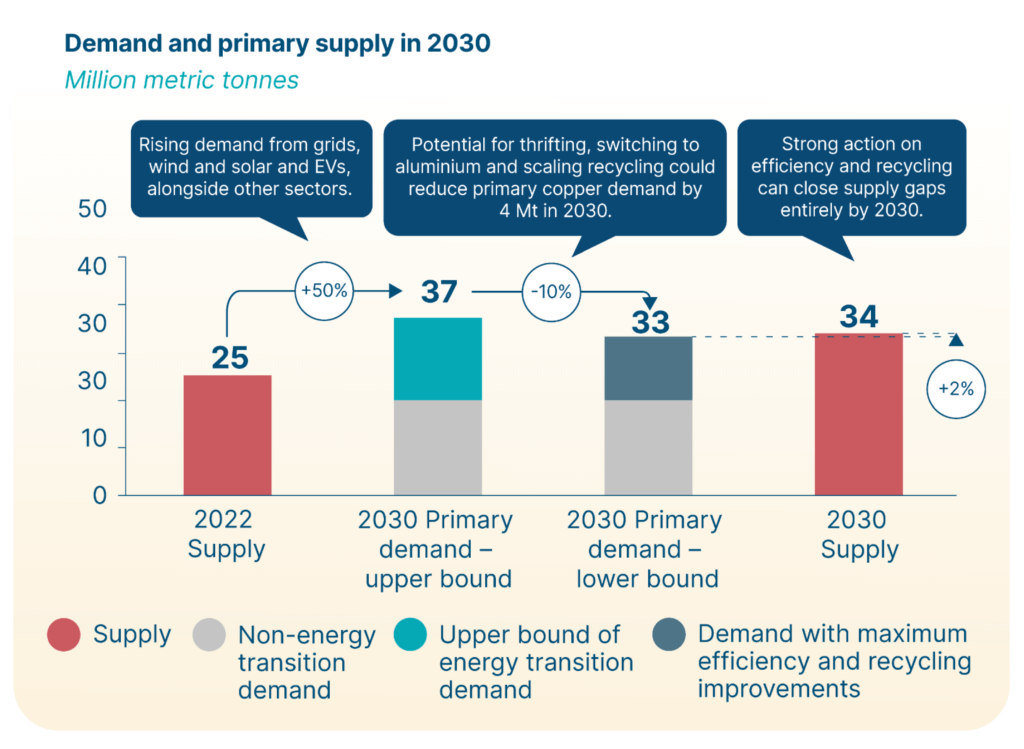
Projected mineral demand is not a static number and can be reduced significantly through complementary strategies such as
- targeting minerals circularity with efficient end-of-life handling and recycling for mineral-rich products;
- mineral efficiency through optimizing product design for minimum material use and waste; and
- through a system-wide optimization and redesign with scaled public transportation to reduce the total demand for individual passenger electric vehicles (EVs), or utility-scale solar to reduce need for individually-owned solar panels.
Despite the potential and necessary mitigation of total demand for minerals, a mismatch in supply and demand is likely in some cases and leads to a broader issue. The environmental and human dimension of this resource dilemma emerges through the long and varied roster of common impacts with which these metals and minerals are extracted today. The roster includes human rights abuses, worker and labor violations, forced displacement, Indigenous land rights violations, water pollution, demolition of whole communities due to the collapse of mine tailings, and many others.
None of the impacts above are unique to the mining industry, as many are rampant in fossil fuel extraction, which itself resides in a special category of impact as the cause of the all-consuming climate crisis. These all-too-common facets of mining present a significant liability to the climate movement, the energy transition, and social justice goals broadly. With the clean energy transition and the subsequent growing demand for materials, we have an opportunity to align with new partners towards advocacy to reshape and drastically improve mining practices. Philanthropy can play a unique role in helping bring together a diverse and global community of advocates to elevate a just path toward clean energy.
Taking responsibility for a clean energy transition
Moving towards our climate goals with a minerals-based clean energy system will require three areas for climate philanthropy to collaborate in, learn from, and lead on. ClimateWorks focuses our attention on these areas as we evolve our thinking and work in this space.
Where we collaborate. First, the climate movement needs to ensure that we are not unintentionally compromising the well-being of a selected group of people for the promised greater good of humanity. That means tackling the opaque and harmful status quo of the mining industry. We must collaborate with partners and advocates who have been supporting communities impacted by the mining industry for decades in demanding reduced impacts. Potential strategic areas for collaboration include corporate accountability, anti-corruption, land rights, and other campaigns and workstreams.
Responsible mining is possible but rare and far from the industry standard. The just energy transition is one where mining companies are responsible and accountable for
- reducing life-cycle emissions from extraction and processing of materials;
- mitigating environmental impacts on local communities and ecosystems;
- avoiding negative social, political, and economic ramifications of their activities; and
- sharing economic benefits from mineral extraction with local communities.
The Initiative for Responsible Mining Assurance, a voluntary standard, is a key tool to drive transparency and improvements at mine sites. Still, it is not a substitute for stringent regulatory policies. Regulations and mechanisms for accountability are needed to reshape the mining industry and improve the value chain. Here, our natural allies are partners from the conservation, human rights, and resource governance spaces.
Where we learn. Second, we need to center benefits to mining-impacted communities and mineral-rich countries through efforts to expand and significantly improve mining for transition minerals. We see this as an area for deep learning through greater engagement with mining-impacted communities and civil society in mineral-rich countries. In the case of community benefit sharing, there is a rich and growing body of research and best practices on durable equity-sharing models. In these models, direct reinvestment into local livelihoods supports communities’ ability to thrive.
Areas of learning come from benefit sharing in renewable energy build-out and across countries that recognize Indigenous rights. Low- and middle-income, mineral-rich countries are simultaneously looking to leverage their mineral resources to bring lasting economic development to their people. Countries across Africa, Southeast Asia, and South America are looking to move from the ‘extraction-for-export’ model to extraction-to-processing and manufacturing. These new models can retain more economic value, domestic jobs, and a greater stake in the energy transition for communities and national interests.
Where we lead. Third, we must focus on mindful resource use as we build a new energy system. Recycling, manufacturing efficiency, second- and end-of-life use, and safe disposal are all areas where the climate movement can lead. We still need a lot of technological innovation to improve material efficiency and maximize the recyclability of minerals, and we can get there.
Key near-term priorities should include:
- advocacy to regulate and support innovation to improve the efficiency of batteries and other clean technologies;
- shifting to new technologies that reduce material demand, which will help close supply gaps to 2030; and
- advancing research, regulations, and economic incentives to scale recycling and reuse.
Current recycling rates are low, but as stock turnover grows in the upcoming decades, secondary supply will scale due to end-of-life recycling. By 2050, we could meet the majority of new clean energy demand requirements through secondary supply. For instance, research shows that 80 to 90% of EV batteries could be collected, reused, or recycled by 2040 or 2050.
A clean energy future with circular minerals and material-efficient technology is a no-regrets pursuit for the climate movement.
An opportunity for the climate movement
We know that we can’t have an energy transition without clean technologies, and we can’t build them without responsible minerals. We also know that the climate movement alone isn’t going to solve development, global inequalities, neo-colonialism, imperialism, racism, and a host of additional societal issues that are our collective burden.
However, the climate movement can and should be in greater solidarity with movements to advance those social issues because it will take all of us to do the unimaginable.
The role of climate philanthropy, then, is to recognize a collective opportunity to join across advocacy spaces. Together, we can dedicate substantial effort towards an area of work — metals mining and supply chain — that we probably never thought needed our support. While it’s obvious that we need something better than fossil fuels, the path to getting there is full of complexities and has led us to a crossroads.
Recognizing that the energy transition needs to center responsibility, accountability, and justice, philanthropy must shape the growing clean energy supply chain according to the values of our climate ambition. The climate movement can support this transition to maximize benefits to people and livelihoods, minimize environmental impact, and ultimately enable a greater coherence between a climate-safe future and the pathway to achieving it.
As ClimateWorks and our philanthropic partners are determining an individual and collective way forward, we invite partners to hold close tensions between environmental and social impacts and benefits. A nuanced look at minerals for clean technologies offers an aligned path forward to address climate change and extraction impacts, simultaneously.

Understanding the tradeoffs between different solutions can help guide informed decision-making and advance ambitious climate goals.
The future of the climate solutions space is teeming with “what if” questions. What are emissions reduction implications if carbon capture technology accelerates — or fails to materialize? What if the momentum for electric vehicles continues to grow? What if biofuels suddenly take off?
To advance a research agenda that addresses these and other similar questions, we partnered with the Pacific Northwest National Laboratory (PNNL) to model a panorama of “what if” questions using constraint scenarios — 16 so far with more planned — using data from the Global Change Assessment Model (GCAM). These scenarios form the basis of our report Achieving global climate goals by 2050: Pathways to a 1.5° C future, which follows an inaugural 2020 report.
The Central and Ensemble scenarios
This year’s report introduces for the first time an Ensemble of scenarios, which allows us to test the robustness of the assumptions in an anchoring Central scenario. In these scenarios, we attempted to identify parameters that would limit global temperature change to 1.5o C by 2100 with limited overshoot, which is in line with the Paris Agreement and used in IPCC Working Group III scenario definition. We rank from six parameters “zero” to “low” to “medium” to “high” (Figure 1) using various criteria (behavioral or lifestyle contributions are held constant as a parameter):
- Bioenergy
- Carbon capture and sequestration (CCS)
- Technological carbon dioxide removal including react air capture (CDR & DAC)
- Electrification of road transport
- Nuclear generation
- Renewable energy
With CSS, for example, a “zero” on the scale would mean there is no carbon capture technology on the market, whereas “high” indicates that the cost of the technology is 20% more affordable than predicted. More information on the scaling can be found in the technical summary of the same report.
While we use the Central Scenario as an anchor in much of our analyses, we recognize that the future of climate change mitigation efforts is consumed by important “what if” questions. We account for these uncertainties in the ClimateWorks Scenario Ensemble, or “Ensemble” for short — which helps us answer these essential “what if” questions.
Figure 1: Modeling parameters for Central and Ensemble scenarios
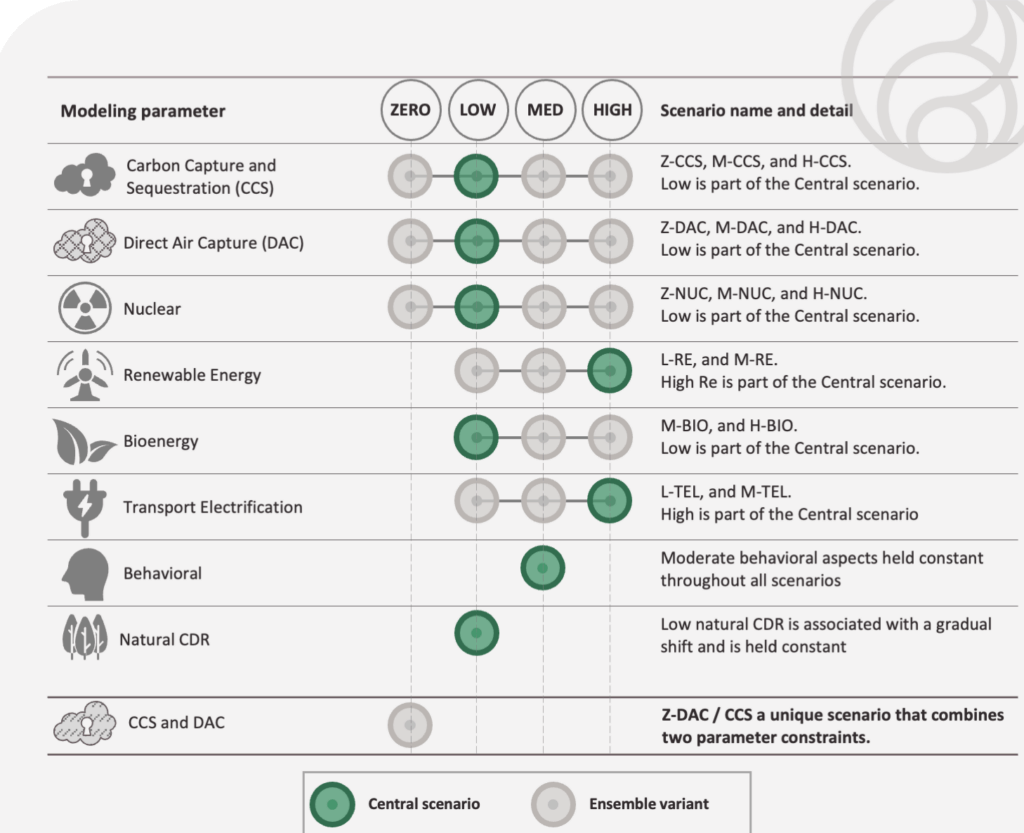
To obtain various outcomes for our Ensemble, we hold the parameters and levels of the Central scenario constant while modifying one component at a time. This is often referred to as constraint analysis. In this case, we are turning the dial up or down, thus incentivizing or constraining the deployment of specific mitigation options or underlying access to certain types of energy.
Answering essential “what if” questions about climate solutions
By using constraint analysis, we can start to answer essential “what if” questions about potential climate change mitigation pathways. For example, what if we are only able to mobilize low levels of transport electrification rather than high levels? These lower levels of electrification might represent a failure to scale electric vehicle options due to either a materials constraint or failure of policy ambition, which would need to be made up elsewhere in order to maintain a similarly stringent emissions pathway. We can then identify appropriate tradeoffs, like increasing productivity measures, electrification, and efficiency options. We discuss these transportation interactions in more detail in another blog post.
The Ensemble helps us answer a second important “what-if” question: what if we fail to implement carbon dioxide removal (CDR) technologies in the form of carbon capture and sequestration (CCS) and direct air capture (DAC)? A Zero-CCS/DAC scenario triggers one of the greatest challenges for the model in maintaining a stringent emissions pathway. If carbon dioxide sequestering technologies fail, our ability to meet stringent temperature targets becomes ever more difficult to achieve (Figure 2). Our understanding is that with a slower and tepid effort to reduce emissions, we increase our reliance on technologies associated with carbon dioxide removal in the future if we maintain 1.5° C as the ultimate goal. And if these technologies fail to materialize, the probability of reigning in temperature rise becomes more uncertain.
Figure 2: Global emissions pathways and temperature outcomes
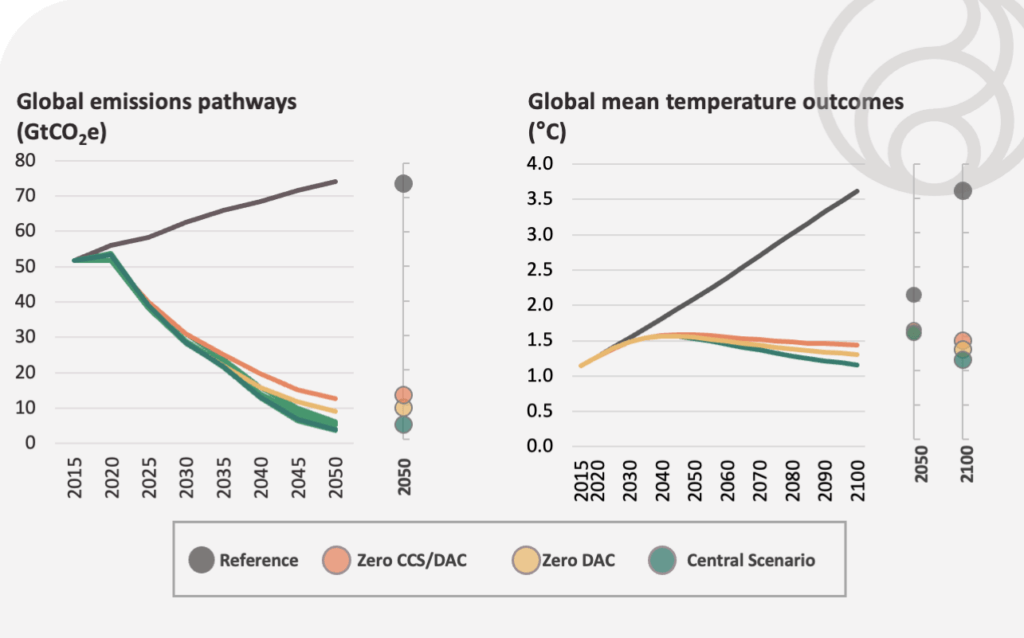
By considering 2050 projections for emissions and electricity generation shares, we can see a notable difference between scenarios depending on whether they incorporate CCS and DAC — especially when it comes to the three sectors of electricity, industry, and technological CDR (Figure 3).
Figure 3: Comparing Central, Zero DAC, and Zero/CCS DAC scenarios based on2050 emissions and electricity generation shares
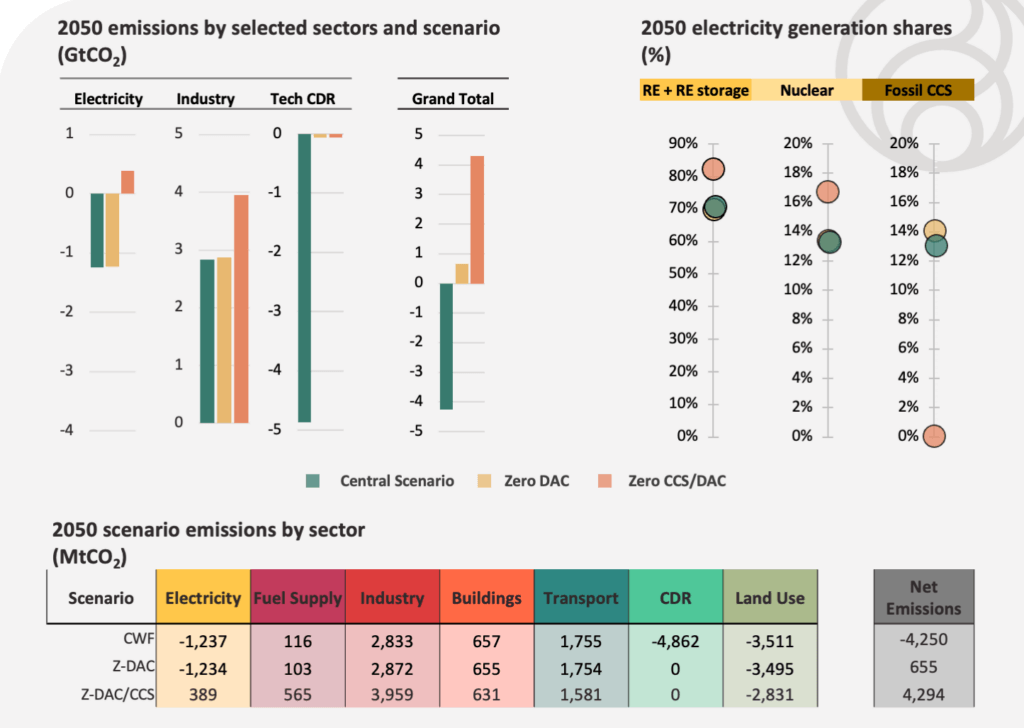
Yet another important example involves the role of bioenergy. Fuels derived from bioenergy are assumed to produce lower emissions because they utilize plants’ natural carbon-sequestering ability. Plants take carbon dioxide out of the air and the burning of the fuels puts the carbon dioxide back. Thus, depending on the processing and distribution of these fuels, bioenergy is considered far lower in emissions in comparison to fossil fuels.
What if bioenergy were scaled? While our Central scenario has a low bioenergy constraint (defined as 100 EJ of primary energy by 2100), we also developed a Medium and High scenario (defined as a max of 150 EJ for the Medium and over 200 EJ of primary energy in the High scenario). And while such scaling of this energy can be beneficial in reducing emissions of key sectors, the impacts on land use can be quite dramatic. As shown in Figure 4, net land reallocations climb in each of these scenarios, and in the High scenario, there is more than 6 million km2 of dedicated biomass production by 2050, equivalent to twice the landmass of India. This would have a huge impact on the competition over land and raise concerns around biodiversity. This means that while bioenergy has a role to play, it is worth considering constraints given the large potential impacts of scaling its use.
Figure 4: Land shift implications of scaling bioenergy
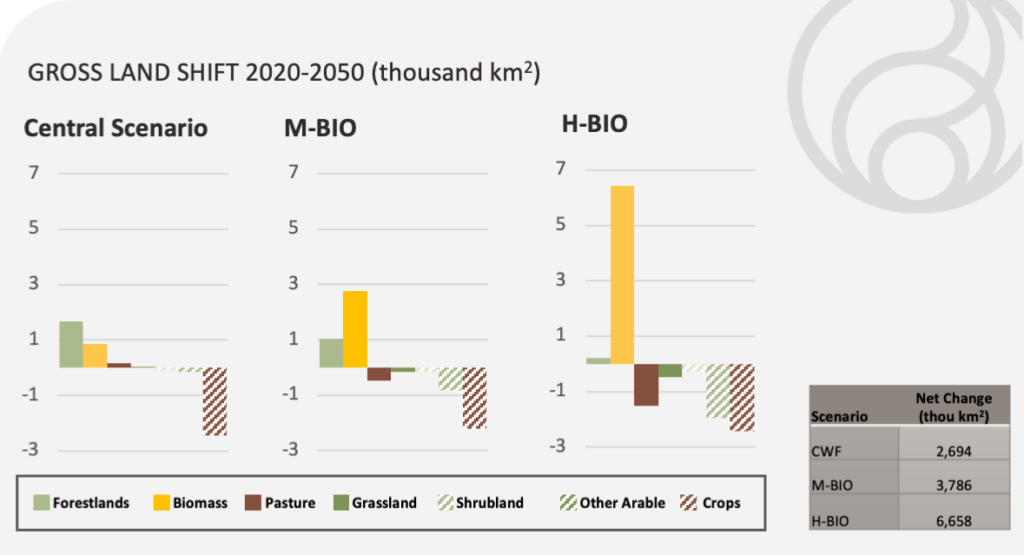
Potential areas for future analysis and exploration
As shown in the previous visuals, the Ensemble gives us a more comprehensive understanding of potential future scenarios given changes and constraints across different geographies and sectors. This allows us to better inform and support our responses to the many “what if” questions posed or those that might come up in the future. Having this data available also allows us to explore the co-benefits of pursuing differing mitigation options. An Ensemble provides essential knowledge and strategies and invites further engagement, curiosity, and collaboration for solutions.
As climate change technologies evolve and new challenges arise, we continue to pose “what if” questions in our work and to test the relevancy of our assumptions. Funders can use this data to help guide their decision-making. In a world full of “what if” questions, our Ensemble can help pave a path toward informed and ambitious climate philanthropy.
This journey is ongoing: we intend to update and expand our Ensemble with additional scenarios in the near future, consulting with the philanthropic community on potential areas of interest. We are already exploring several new topics, including the role of green hydrogen, the potential of limited and/or ambitious lifestyle changes in terms of energy use and dietary shifts, and the inclusion of a wider array of CDR options. With your help, we hope to answer the most important climate question: what if we start taking bold climate action right now?
Download the full report, Achieving global climate goals by 2050: Pathways to a 1.5° C future, to read about important “what if” questions and more. The full report explains the Ensemble results per sector, gas, and geography in further detail. Additionally, ClimateWorks has, for the first time, made publicly available the data that underlines the creation of the report, which contains a file of our GCAM-CWF Ensemble. We hope these data can serve as a helpful resource for users to further explore these scenarios.
Contact ClimateWorks to learn more about climate change mitigation opportunities, how to develop a climate strategy, and how we model our scenarios.
Special thank you to Majlis Walker for providing editorial support for this article.
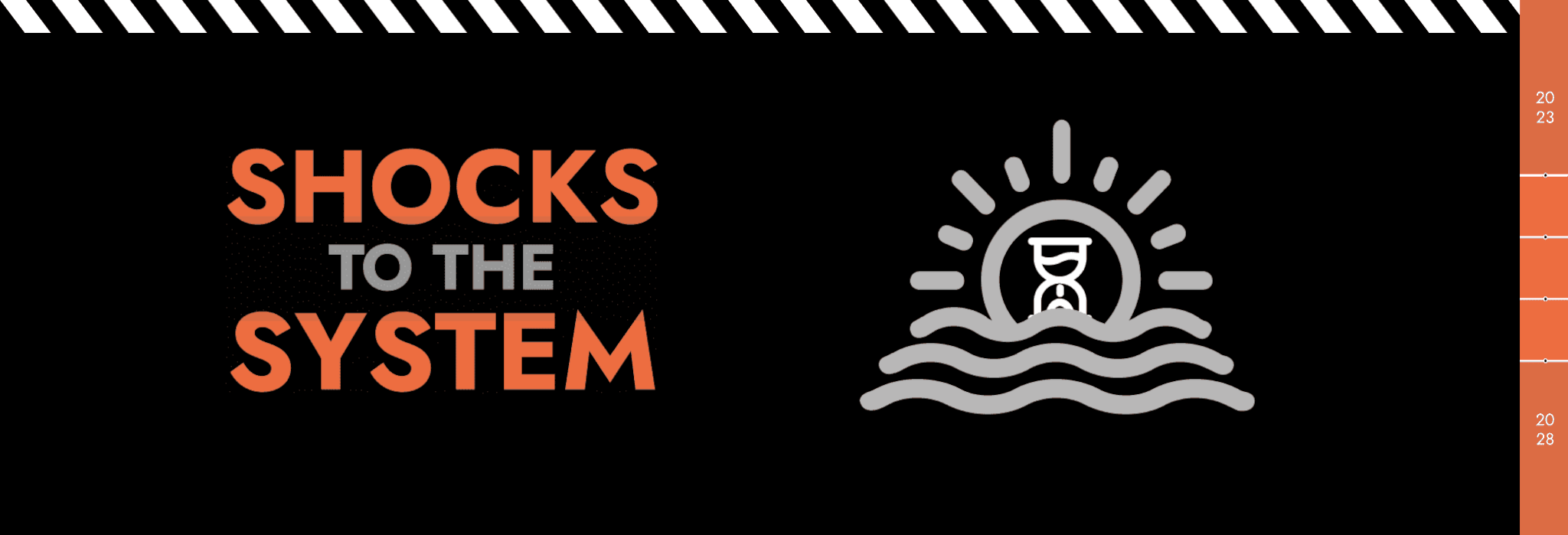
In our current “decade of disruption,” many global systems are becoming more vulnerable and volatile. Key systems such as food and energy, as well as groups such as businesses, organizations, and communities, need to be better equipped to understand and act in the face of a rapidly changing external landscape and respond to unpredictable — yet increasingly likely — shocks to the system.
For all the substantial progress that climate philanthropy has made over the past decade, it still lacks effective tools to regularly scan the horizon to identify and consider issues that could propel or hinder climate action. There is an unmet and essential need for climate philanthropy to look further, think differently, and prepare better, to be able to act more strategically when tectonic shifts occur globally.
Over the past several years, ClimateWorks and partners have sought to enhance collective capacities to anticipate how to factor events, trends, and exogenous factors and scenarios into climate action philanthropic strategies and investments. Examples of published work include Broadening the Dialogue: Exploring Alternative Futures to Inform Climate Action, Using futures analysis to develop resilient climate change mitigation strategies, and Philanthropic climate priorities under Covid-19 recovery scenarios.
In February 2023, ClimateWorks partnered with Forum for the Future to explore innovative ways to engage the climate philanthropy community on risks and opportunities out to 2028, to understand the implications of future trends for climate investment plans and optimize the potential positive impact of these plans. Together we developed a fast-paced immersive game entitled “Shocks to the System: Fast Forward to 2028” to test decision-making abilities based on macro trends and explore specific issues within different mindsets and trajectories.
Horizon scanning by Forum for the Future: Trajectories and signals of change
Horizon scanning is a practice of Futures in which we try to detect potentially important developments through a systematic practice of scanning for, and analyzing, potential risks and opportunities as they relate to a specific issue area. Forum for the Future uses horizon scanning to help organizations make sense of the changes happening in the wider world and understand how that change could cause shifts in their operating context.
A critical part of horizon scanning is to identify ‘signals of change.’ Signals of change are seeds of a possible future. They represent any development, idea, or innovation that points to a future possibility different from today’s norm. Of particular interest are signals that point to the possibility of significant future change or illuminate an aspect of ongoing change. Signals help us think through the future more expansively and to anticipate unintended consequences of developments we can see signs of today.
During 2020 we witnessed one of the largest pandemics of our lifetime and the pace of change seemed to speed up as systems like education, healthcare, and food delivery were all disrupted. As a way to help track and make sense of this change, Forum created a set of future trajectories — four possible pathways that are linked to different mindsets about the future.
The deepest point of intervention in the system is our mindset. Goals, power structure, rules, and culture all arise out of mindset. Our mindset shapes how we interpret and engage with signals of change, and the signals that rise to the top, in turn, shape our mindsets. This was certainly the case during the pandemic when certain developments led to a scarcity mindset over one of abundance, resilience, and transformation.
Shocks to the System: Fast Forward to 2028
The repercussions from recent global events and trends — including the Covid-19 pandemic, the war on Ukraine, unexpected national elections, and rising and persistent inflation — have intensified philanthropic funders’ interest in enhancing horizon scanning capacities and exploring tools to test the resilience of strategies. As we face an increasingly uncertain and unpredictable future, businesses, governments, and philanthropic organizations must develop strategies that are more resilient and broader in scope than ever before, as seemingly external factors have the power to fundamentally shift systems.
So, how do we build more foresight and resilience into our strategies to enable better decision-making about the future? We turned to Forum’s trajectories to provide a framework for understanding and interpreting trends, how they interact, and how they might evolve. We took Forum’s established trajectories, played them out to 2028, and updated them to include trends and signals around global food price shocks and minerals critical to the energy transition as two areas that have seen significant changes in a short period of time and are likely to cause significant impact on climate action. Based on interviews and desk research, the updated trajectories explored the macro trends underpinning shocks across the globe and gave way to potential pathways.
Rather than a traditional report, we sought to convey this information in a format befitting the volatility and rapid pace of the topic. For this reason, we determined that a short, immersive game would be the best way to engage the climate funding community in an interactive and creative way. Additionally, making the game free and accessible through a downloadable format ensures that people and organizations who wish to explore similar issues can benefit from our research and thinking.
Shocks to the System is a game about high-stakes decision-making with limited information and how the trajectories of those decisions play out into the future. Decision-makers in philanthropy have to make important decisions regarding where in a system to intervene, what interest groups they might be impacting, and how risky an intervention is in the likelihood of succeeding or the time needed to scale. We tried to capture these aspects of decision-making in the game.
Philanthropy can use the game in a few ways:
- To start or re-energize a conversation about climate funding priorities
- To experience high-stakes decision-making and the futures mindsets associated with those decisions
- To explore complex intervention points that we face today, specifically around food prices and minerals for the energy transition
We hope that by playing the game, participants can surface tensions and assumptions about the future. The game is intended to be paired with a longer conversation about why certain decisions were made, and the complexity and climate impact of food prices and minerals for the energy transition, in order to bring more resilience to future decisions.
Next steps for horizon scanning: three insights to take forward
As we continue to explore how we collectively enhance the philanthropic community’s horizon-scanning capabilities, we share three key insights that we’ve learned so far.
Exploring all types of horizon scanning. We developed the Shocks to the System game as an experimental, new way to explore future risks and opportunities and how we factor these into more strategic decision-making. Next, we need to explore all types of horizon scanning to expand our collective toolsets and frameworks. The goal of horizon scanning is not to forge one path for climate funders. Instead, it is to examine key insights from non-traditional lenses, challenge group thinking, and identify gaps or risks in individual or collective strategies on the basis of possible/probable futures.
Collecting, tracking, and interpreting signals of change. The future is inherently uncertain. While many future changes will be unpredictable, beginning to systematically collect and monitor ideas, trends, risks, and innovations, across different sectors and regions, and thinking through how these developments might point us to futures different from today’s norm can help to be better prepared. Tracking signals of changes in collaboration with others can give us a wider view of the future, help us to start to develop a playbook for how we might respond to shocks, and expose gaps and risks that might exist in our current strategies and where we might need to be more resilient.
Listening to different voices. Risk events can happen at any time and from anywhere. Many of these shocks will come from outside of the climate space. Effective horizon scanning tools and frameworks must engage with a diverse range of expertise and intelligence from a variety of non-climate disciplines. Furthermore, it is critical to monitor and understand signals of change that are happening across different regions — how we translate macro-level trends to implications at the country level, and how regional developments and dynamics might cause large-scale disruptions at the global level. To this end, working and learning from partners in different regions and contexts will also be an important component of our horizon-scanning efforts going forward.
We invite you to explore the Shocks to the System: Fast forward to 2028 game.
About Forum for the Future
As a leading international sustainability non-profit, Forum uses expertise in futures and system change to help catalyse change on key global challenges: the climate crisis; transforming our food systems; and sustainable value chains and livelihoods. We work in partnership with businesses, governments, and civil society to accelerate the shift to a more sustainable future.
A new report provides a fresh perspective on climate philanthropy.
ClimateWorks Foundation’s philanthropic research program has historically focused on insights specific to foundation grantmaking for climate change mitigation. We share this research through publications such as our annual report on funding trends in climate change mitigation philanthropy.
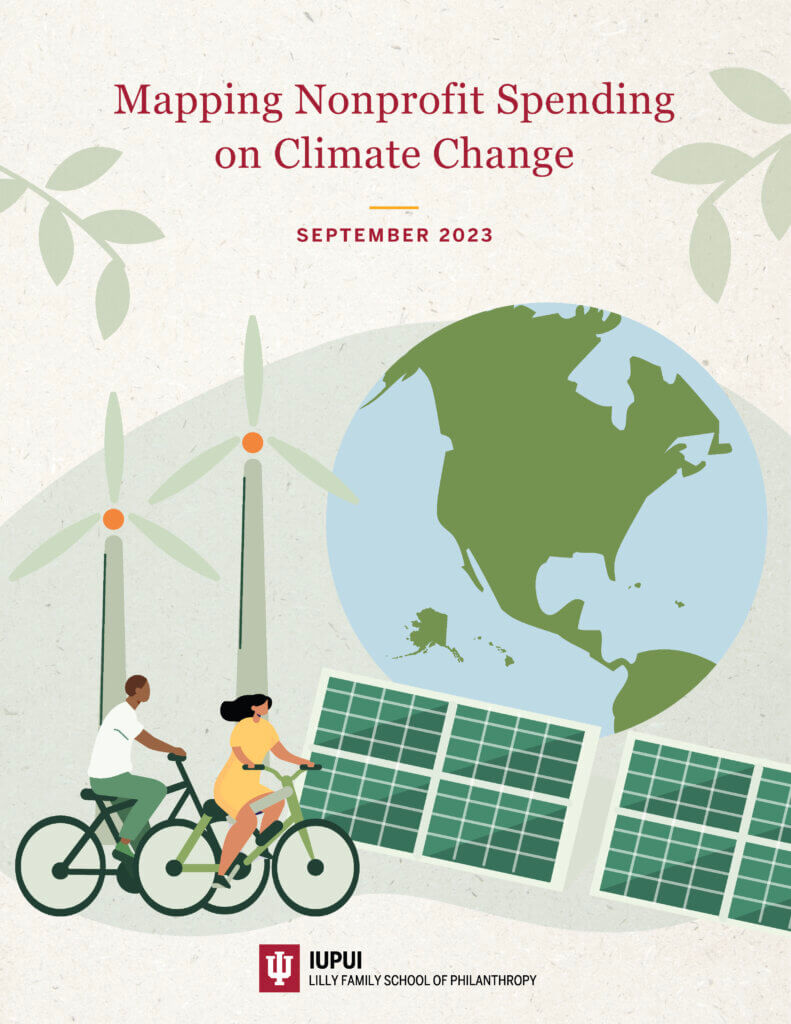
New early-stage research from Indiana University’s Lilly Family School of Philanthropy (the Lilly School) with support from ClimateWorks broadens this scope with bottom-up research examining how U.S.-based nonprofit organizations are allocating their budgets toward climate change.
Learnings from this pilot project confirm some estimates from ClimateWorks’ previous research and raise other new questions to further explore in future research. Here are five things we are taking away from this work:
- Sizing the Sector: The report estimates that nonprofits based in the United States spend between USD $7.8 and $9.2 billion annually on work that addresses climate change, including all funding sources. Approximately 88% ($6.8 to $8 billion) of these total climate expenditures were funded by philanthropic sources, with the remainder from government sources (7%) and fees collected for services (5%). Of this total, roughly half of funds targeted mitigation, 14% targeted adaptation, and the remaining one-third did not fit cleanly into these two categories.
- Regional Spending: Although this survey focused on U.S.-based nonprofits, the respondent organizations focus only a little more than half (54%) of their climate expenditures on strategies focused on the United States and Canada. This is not entirely surprising, as many large global NGOs are headquartered in the United States but work globally or have affiliates elsewhere they may transfer support to. Nonetheless, it is an important reminder that analyses of funding by geography should take into account where the work is ultimately happening, in addition to where grantees are based.
- Tactics and Sectors: Charitable organizations use a variety of tactics across a range of sectors to achieve their goals for climate action. This report reveals that “policy-based approaches” receive the largest share of surveyed organizations’ climate expenditures (30%). Respondents also listed policy-based approaches as one of the biggest funding gaps, indicating the importance of this tactic as a key enabling lever for climate action. Energy comprised the largest focus area of the sample, including both energy use (35%) and energy supply (32%). Land-use-centric approaches follow, accounting for 23% of expenditures.
- What we can learn from a bottom-up view: Much research in the philanthropic sector focuses on the donors — who are they, what are they giving to, and why? The incentives for this are two-fold. First, large donors, whether individuals, foundations, or governments, are more concentrated and easier to study — and in the case of foundations and governments, often legally obligated to disclose their giving. Second, there’s a large constituency of fundraisers and organizations creating a market for this kind of information. This report takes the opposite view — it asks implementing organizations how they are spending funds in service of the climate fight, regardless of where the funds come from and regardless of whether the funds were originally restricted for climate causes or not. This, for the first time, allows us to get a clearer view of the U.S. nonprofit sector’s total spending allocations toward fighting climate change, revealing how organizations have allocated their resources, including to fill holes in causes under-supported by donors, and where we still see persistent funding gaps.
- What we were not able to learn from a bottom-up view: One initial goal of this new research was to better understand how individual donors are supporting climate change and to begin moving to a place where the level of detail available on funding by non-foundation sources approaches the level of detail available from foundations. This level of detail might cover funding not only by sector and region but also dive into sub-sectors. Such analysis may involve for example, questions around how much funding in the ‘transportation’ concentrates on zero-emission vehicles vs. increasing transit mode share vs. developing green fuels. These are three very distinct strategies currently collapsed into one in this data. After an extensive scoping process, it was determined that this level of data will generally not be available in a bottom-up data collection exercise of this type, due to taxonomy and definitional issues as well as the enormous time burden it would put on respondent organizations. We remain optimistic that alternative routes to support data discovery of this kind may emerge as the field develops.
Read the full Lilly School report.

In April 2023, the ClimateWorks Global Intelligence team published Achieving global climate goals by 2050: Pathways to a 1.5° C future — a climate modeling report that outlines the transformations needed to meet the ambitions of the Paris Agreement. To develop the scenarios in the report, ClimateWorks partnered with the Pacific Northwest National Laboratory (PNNL) in using their open-source model, the Global Change Analysis Model (GCAM).
For the first time, ClimateWorks has made the report’s datasets freely available for download as a resource for the climate research community. As a result, readers can use the tools developed in partnership with PNNL to track the distribution of global emissions by source, sector, and end-use. By interacting more closely with the data, funders, and other users can consider the broader pathway implications of their climate strategies.
Why are we sharing these datasets?
While this is the second iteration of this climate modeling report, it is the first time we have made the full corresponding datasets publicly available. By allowing replicability and comparability of our numbers, we aim to facilitate discussion, promote accountability, and spur further research as users perform their own explorations and analyses.
We treat the research behind our scenarios not as final but as a living exercise. We are constantly learning; expanding our scenarios; researching new technologies and trends; engaging with researchers, issue area experts, and funders; and promoting discussion to further our knowledge and enhance our work. For us, sharing this data is a way to broaden our network, engage with the climate solutions community, and provide an example of transparency. We plan to continue this practice for future iterations of this report, which we aim to update roughly every two years. As with the report itself, we aim to improve our processes to meet the demands of our user community.
How can users interact with the data?
There are several ways for users to interact with the data files associated with the report. This can involve replicating the graphs and tables from our report or comparing them with other models. These comparisons can involve models such as the World Energy Outlook, outputs from the AR6 Scenario Explorer hosted by IIASA, or outputs from other scenarios generated using GCAM (the model underlying our analysis), such as the Shared Socioeconomic Pathways for various temperature outcomes.
We find a couple of graphical representations of the data particularly useful in our work. First, the Global Region Scenario Data file allows users to reproduce graphs like the Sankey diagrams shown both here and in the full report (Figure 1). These diagrams visualize the emissions flows for specific years according to their source, sector, greenhouse gas type, and end-use. Such graphics are rarely shown due to the complexity of the data. Nonetheless, they help strengthen our understanding of how emissions are generated and tracked across different processes.
Figure 1: 2020 upstream and on-site emissions counting
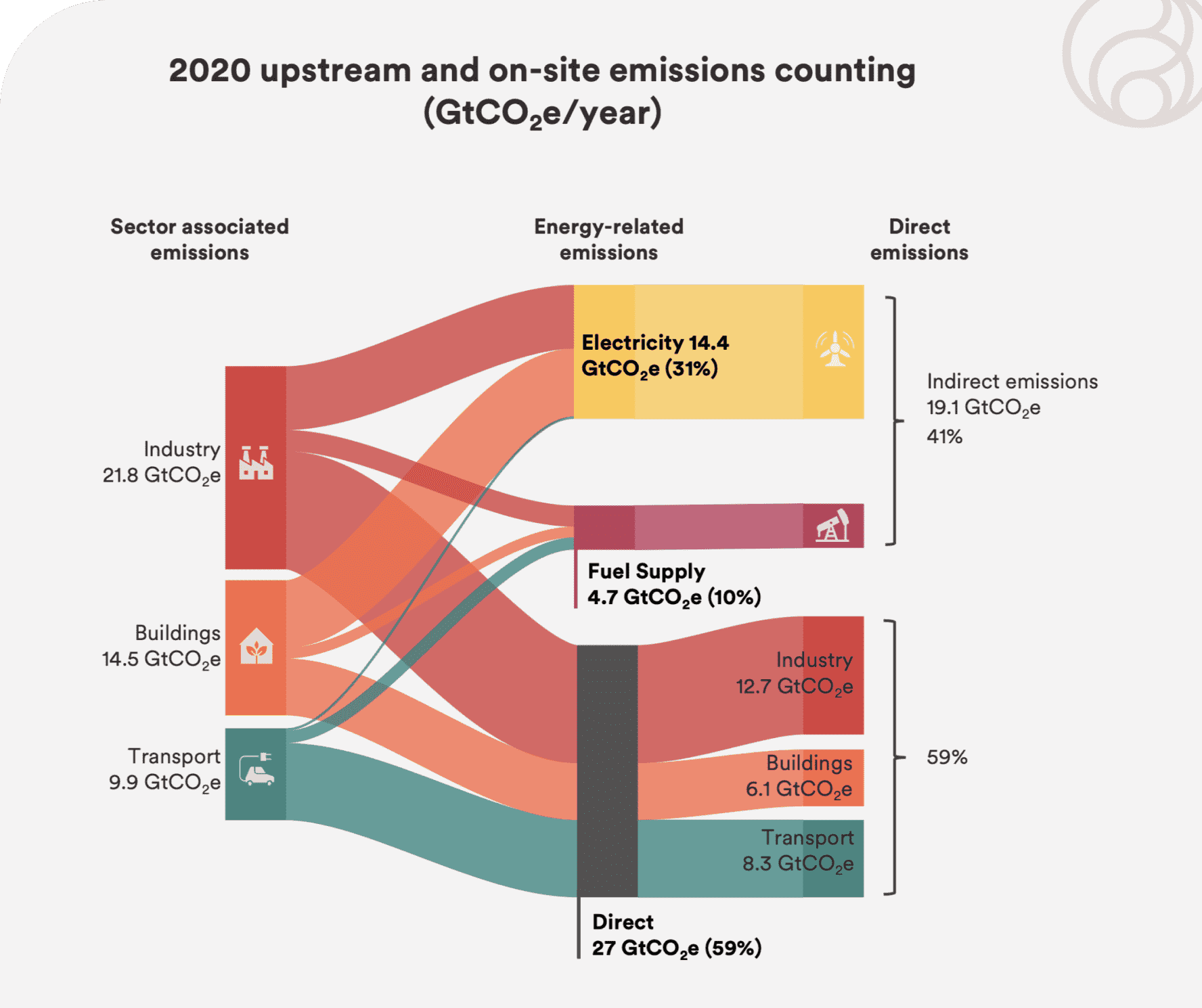
When visualized in a Sankey, the data helps us explain what we refer to as the “more pie for everyone” problem. In basic terms, there is a lot of double counting. Programmatic strategies are often based on sectors and claim to be addressing shares of the total emissions pie. However, if you added them together, you would get a result of more than 100% (see Figure 1 chart for example).
While this “double counting” is sometimes due to error, it more often means that the calculations include associated emissions that are counted elsewhere in order to strengthen their appeal as a priority area. A particular industry, for example, might only report its onsite or direct emissions. This ignores emissions from associated offsite electricity generation and further excludes associated emissions that result from the extraction, processing, and distribution of fuels used. Our data allow for narrow and expansive definitions of associated emissions and the inclusion of interactions with other sectors. In effect, this is taking into account supply, demand, and the interconnectivity between sectors. For philanthropy, this allows for a more nuanced understanding of the solution space by revealing system interactions.
Another useful representation of the data involves comparing outcomes from the Ensemble of scenarios at the heart of what we refer to as tradeoff analysis. We will publish a follow-up blog post on tradeoff analysis, which involves using constraints and incentives in the model to answer ”what-if” questions posed by partner organizations.
For now, we demonstrate this with the data using two of the scenarios from the Ensemble: the Central and Low-Transport Electrification (L-TEL) scenarios. The Central scenario is a High-Transport Electrification scenario that reaches 100% electrification of new sales for both freight and passenger vehicles by 2050. In this scenario, roughly 90% of vehicle fleets are electric, with the remaining 10% aging out of service thereafter. On the other hand, in the L-TEL scenario, roughly one-third of passenger vehicles are electrified and freight less than 10% by 2050.
In the aggregate, both pathways reach the same emissions result in 2050; however, transport emissions differ significantly. There is a cumulative 2.1 GtCO2e difference and in a highly constrained pathway, this can have a big impact elsewhere. The model compensates by finding commensurate amounts of reductions in other sectors. In Figure 2, we see this demonstrated through emissions outcomes in other end-use sectors: specifically, industry, followed by fuel supply. As emissions outcomes rise or fall in the transport sector, there is a tradeoff as other sectors respond and compensate.
Figure 2: 2050 net and gross sectoral emissions comparison
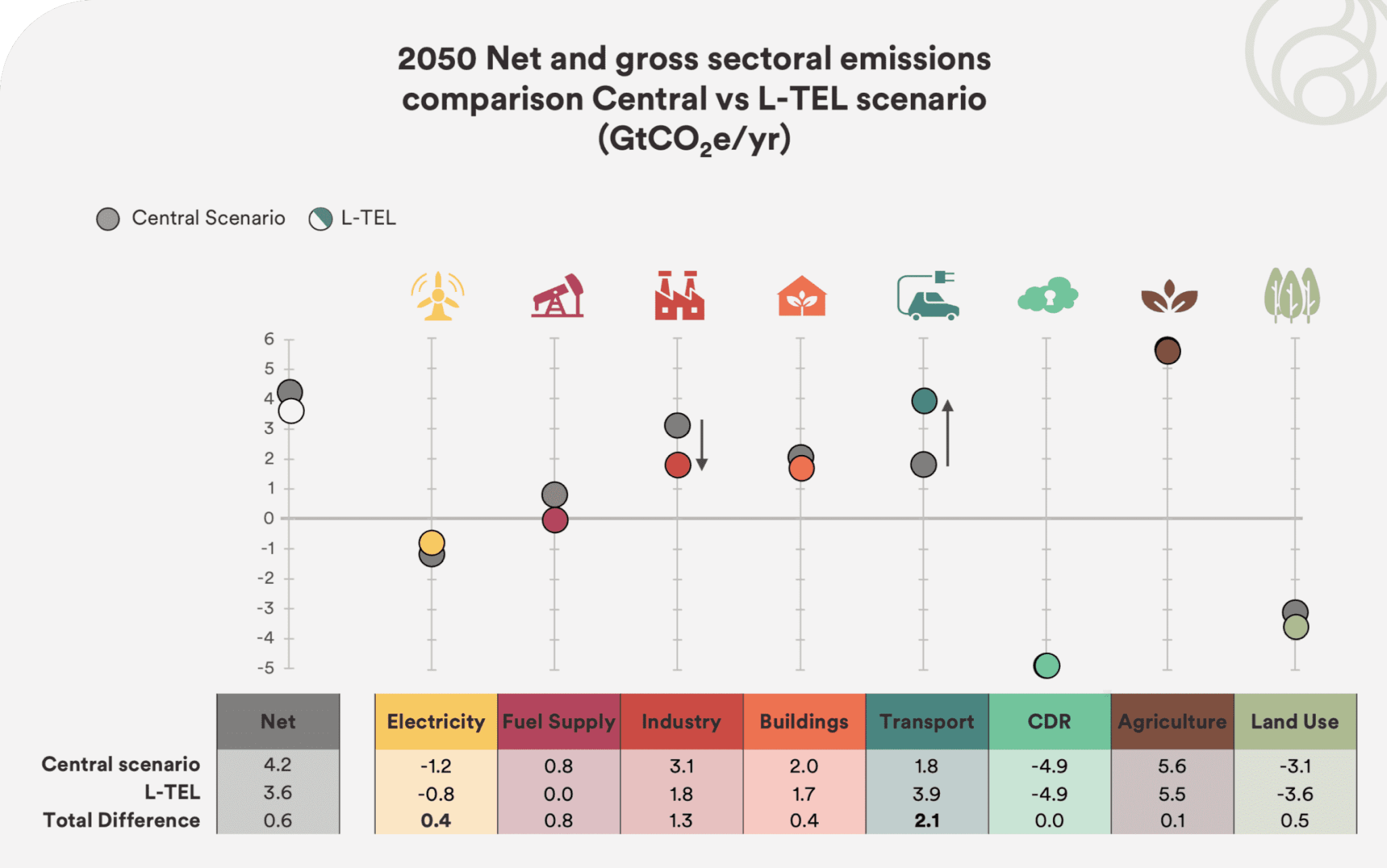
Comparing the Ensemble results reveals interconnections and tradeoffs between the uses of technologies. In aggregate, these comparisons lead to responses that may seem intuitive — for example, that increased ambition and use of a particular technology results in a decreased dependence elsewhere. Nonetheless, the details of where and how interconnected the responses are can still help funders determine where to place emphasis within their portfolios.
Future conversations on mitigation pathways
As mentioned, the data we released alongside our recent report is both an example of transparency and allows for more technical engagement on our pathways for those looking to do so. We understand, however, that not everyone is looking for this level of granularity when it comes to data. This is why we also directly engage with funders to better contextualize the mechanics of mitigation found in our pathways reporting. Understanding these mechanics is crucial for developing an effective climate strategy. We will further explore these approaches in upcoming entries to this ongoing blog series on mitigation pathways.
Read the full report, Achieving global climate goals by 2050: Pathways to a 1.5° C future.
Contact ClimateWorks to learn more about climate change mitigation opportunities, how to develop a climate strategy, or how we model our scenarios.
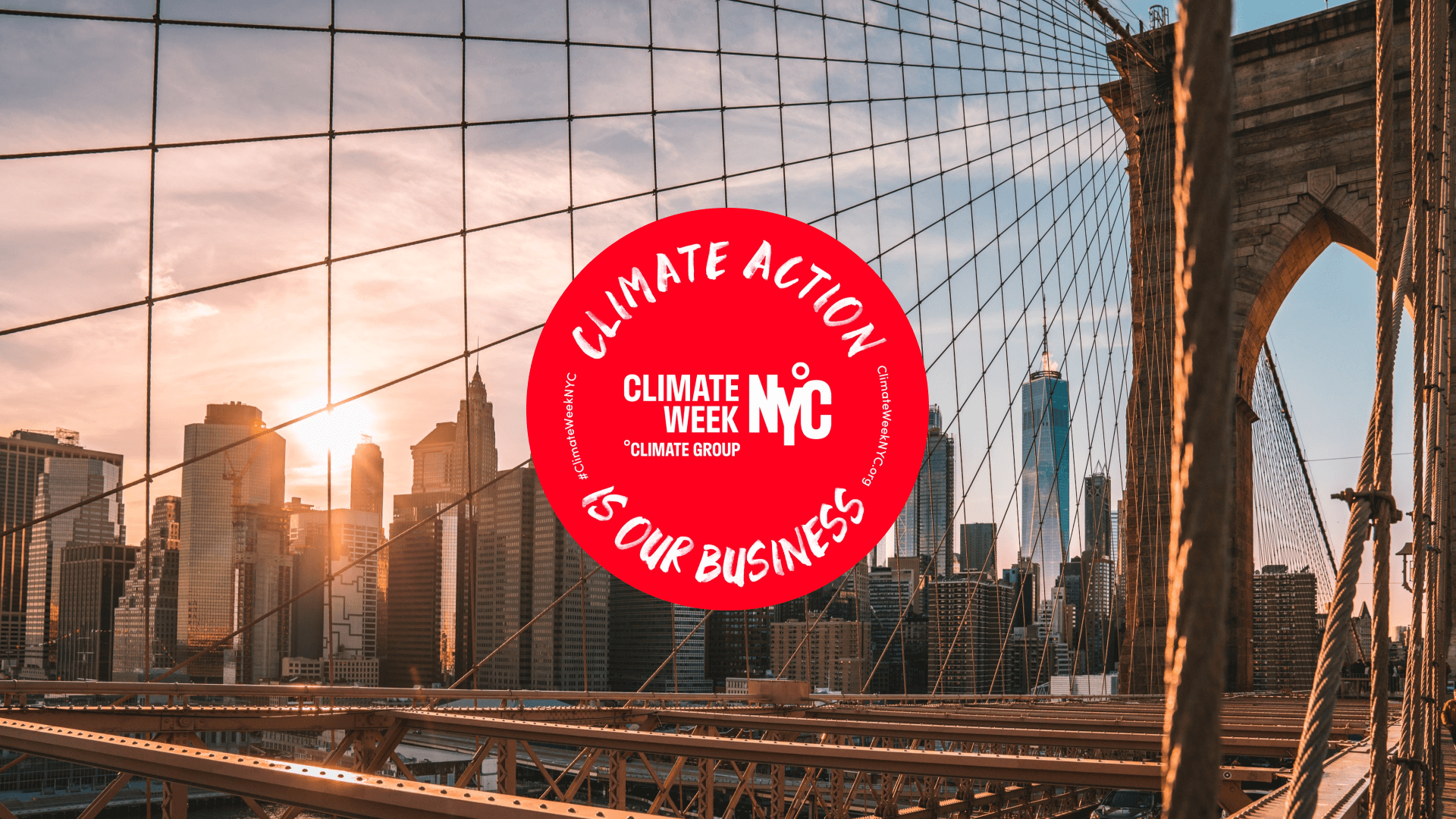
Here’s how you can follow ClimateWorks and our global partners during Climate Week.
Climate Week NYC gathers leaders from the public and private sectors for hundreds of events, in person and online, from September 17-24, 2023. This is an opportunity to galvanize momentum for increased climate ambition and solutions that equitably address the urgent issues communities worldwide are contending with today.
ClimateWorks and our partners will be on the ground engaging in and leading some of the important discussions at Climate Week. Whether you’re joining in-person or online, below are some key events to keep in mind.
ClimateWorks at Climate Week:
The great transport divide: Harnessing collective efforts for electric vehicles in the Global South
Monday, Sept 18; 11:55 AM – 12:50 PM EDT – link to register
Road transport is responsible for 15% of CO2 emissions worldwide. As we increase the speed of transport electrification, we must make sure the switch to EVs happens globally and the benefits to air quality and health are distributed equally. Looking to Latin America and India, it’s clear that the switch presents both challenges and opportunities. Collaboration between governments and the private sector will be critical to the Global South’Manuel electrification journey. ClimateWorks’ Associate Director, Road Transportation Lina Fedirko will be the keynote speaker for the session.
Hosted by Climate Group
The strength to lead: Kicking the coal habit and placing steel at the heart of the green economy
Monday, Sept 18; 11:55 AM – 12:50 PM EDT; Link to register
Steel is the world’s most widely used material – a vital part of the infrastructure we will need in the net-zero cities of the future, yet the production of steel is one of the biggest sources of global greenhouse gas emissions. The last few years have seen an upsurge in low emissions innovation in the sector and technological investment, but at the same time a host of barriers from technical challenges to companies facing significant commercial and structural barriers continue to hamper progress. Climate Group’s SteelZero initiative sends a signal to steel makers that demand for net-zero steel is growing – but there is a long way to go. We’ll be asking, what will the future hold for net-zero steel amid an increasingly fragmented supply chain. ClimateWorks’ Senior Director, Industry, Rebecca Dell, will speak at this event.
Hosted by Climate Group
Trade Policy Impacts on Climate – Opportunities and Challenges
Tuesday, Sept 19; 9:00 AM – 12:00 PM EDT
What are the implications of global trade flows for climate change and the clean energy transition, how do they intersect with programmatic strategies, and how can climate mitigation philanthropy constructively engage on this topic? This event will explore the impact of the EU CBAM, US IRA and BIL, and trade policy more broadly on climate ambition and emerging economies. We will bring together regional experts on the implications of CBAM implementation and other climate/trade policy levers for emerging economies, what the geopolitical responses are and how civil society and climate mitigation philanthropy could and should respond. ClimateWorks’ VP, Programs, Charles McElwee will speak at this event.
Hosted by African Climate Foundation and ClimateWorks Foundation
Making Corporate Data Work For Climate Disclosures – Carbon Call
Wednesday, Sept 20; 11:00 AM – 1:00 PM EDT; link to register
At Climate Week NYC 2023, the Carbon Call is bringing together its members, regulators, standard setters and philanthropies to present actionable solutions that help companies overcome constraints faced when gathering, interpreting and sharing GHG data. These plans – covering the discoverability of data, metadata requirements and a smart digital dictionary, aid companies to deliver on regulatory drivers such as reporting mandates, as well as voluntary disclosures and tracking climate targets.
Hosted by ClimateWorks.
Equipping the Climate Community for the Transition – Building the system for accountability
Wednesday, Sept 20; 2:00 – 4:30 PM EDT
The workshop will be a deep dive into stakeholder priorities and data needs, along with a discussion on how we can better align and collaborate with a focus on unpacking how the existing tools can be adopted or strengthened to meet the needs of a range of levers for accountability.
Hosted by ClimateWorks and ClimateArc
Food Day at the UN General Assembly
Wednesday, Sept 20; 8:45 AM – 5:00 PM EDT; link to register and watch online
Join the Rockefeller Foundation, WWF, the Global Alliance for the Future of Food, and media partner Food Tank, for Food Day on Sept 20th alongside the UN General Assembly SDG Summit 2023 and Climate Week NYC. The special Livestream event will offer global framing for the nexus of food and agriculture, climate, nature, health and finance; key challenges; and pathways for a sustainable, equitable and inclusive food system.
Hosted by Rockefeller Foundation, WWF, the Global Alliance for the Future of Food, and Food Tank
Trailblazing, failing and setting sail: A quest for food systems innovations
Thursday, Sept 21; 9:00 AM – 2:00 PM ET; Link to register
The event will bring together experts from diverse backgrounds, uniting stakeholders across the food system, including youth. We aim to cultivate a community that champions systemic innovation and technology. By fostering collaboration, we strive to inspire action towards a resilient, inclusive, and sustainable food future.
Hosted by Clim-Eat
The Indian G20 Presidency – Sparking Climate Action for COP28
Thursday, Sept 21; time to be confirmed
The event will focus on amplifying India’s G20 presidency successes and sparking dialogue on continuity with Brazil. It will invite key officials from India’s G20 presidency, including incumbent G20 chairs of the Development Working Group, Energy Transition Working Group, Environment and Climate Sustainability Working Group of the Sherpa track, and chairs of the Business20 Engagement group and the Think20 Engagement group. The conversation will also bring an emerging economies perspective on collaborative global efforts for decarbonization, scaling investments, climate finance and supply chains. This event will be followed by a conversation at COP28.
Hosted by ClimateWorks Foundation and ICC.
ClimateWorks Partners at Climate Week:
The March to End Fossil Fuels
Sunday, Sept 17; 1PM; 56th & Broadway, NYC – Link to more details
The United Nations is calling on world leaders to take real steps to lead us off fossil fuels to protect people and the planet. On September 20th in New York, the UN Climate Ambition Summit will gather world leaders to commit to phasing out fossil fuels. Thousands of us will take to the streets before the summit to demand President Biden take bold action to end fossil fuels.
Road to success: picking up the pace of electrification in the heavy-duty freight sector
Monday, Sept 18; 1:45 PM EDT – Link to register & watch online
Heavy trucking is responsible for more emissions than the aviation and shipping sectors combined. Work to electrify lighter vehicles is well established and gathering pace, but we can’t ignore the heaviest, dirtiest vehicles on the road if we’re to meet our climate targets. How can we ensure that trucks aren’t being left behind? What needs to happen, who needs to take the lead, and how can the transition benefit people and businesses?
Hosted by The Climate Group.
The Earthshot Prize Innovation Summit
Tue, Sept 19; 12:30 PM EDT – Link to register & watch online
Taking place during New York Climate Action Week and the 78th Session of the UN General Assembly, the Summit will convene previous Earthshot Prize Winners and Finalists with policymakers, global business leaders, philanthropists, and climate activists to scale their innovative solutions. Prince William, founder of The Earthshot Prize, will attend alongside Michael R. Bloomberg, the UN Secretary-General’s Special Envoy on Climate Ambition and Solutions and Global Advisor to the Winners of The Earthshot Prize.
Hosted by the Event by The Earthshot Prize and Bloomberg Philanthropies
Catalyzing Action for Managed Coal Phaseout
Tuesday, September 19, 2:30-3:45pm EDT – Private Roundtable
Coal power generation is the largest source of carbon emissions globally, and coal -fired generation reached an all-time high in 2022. It is expected to rise for several years further in Asia Pacific (APAC). While the recent uptick in coal-fired generation is likely to be a temporary glitch in some regions, the overall trend is not on track with the International Energy Agency’s Net Zero Emissions by 2050 Scenario. Progress will need to be made as part of wider energy transitions, implemented through greater ambition in country-specific commitments and policy reform, and catalyzed through by global policy frameworks and financing solutions. PPCA, Bloomberg Philanthropies and GFANZ are convening global key stakeholders for a private roundtable to discuss the enabling policy environment and financing approaches needed to facilitate the accelerated phaseout of coal assets. This roundtable aims to bring momentum to the managed coal phaseout agenda by identifying what is needed to drive progress and advance pioneering transactions.
Hosted by Powering Past Coal Alliance (PPCA), Glasgow Financial Alliance for Net Zero (GFANZ), and Bloomberg Philanthropies.
Accelerating to a Zero-Emission Transportation Sector
Tuesday, Sept 19; 3:00 PM EDT – Link to register & watch online
Signatories to the Zero Emission Vehicles (ZEV) Declaration signed on to the global pledge to ensure that all new car and van sales be zero emission by 2040 globally, and by 2035 in leading markets. This level of ambition is critical to avoiding the worst impacts of climate change and will help tackle air pollution, reduce oil dependency, and deliver new jobs. This session will showcase the current progress of ZEV Declaration signatories in reaching this ambitious target and further discuss the importance of a zero-emission transportation sector. Featured senior leaders from across the eight distinct signatory categories will share key insights from their ZEV transitions, including lessons learned and their vision for the future.
Hosted by the Accelerating to Zero (A2Z) Coalition.
Reducing NYC Transportation Emissions: the ZEV for NYC Act
Wednesday, Sept 20; 6:00 pm EDT – Link to register & watch online
Transportation accounted for 28% of NYC’s emissions in 2021. City government has been increasing the purchase of electric vehicles (EVs), but it has not yet deployed a significant percentage of the municipal fleet as 100% zero-emission vehicles (ZEVs). ZEVs eliminate direct emissions and dramatically reduce indirect emissions. The ZEV for NYC Act sets intermediary ZEV purchasing deadlines and requires the City to transition most of its fleet to ZEVs by July 1, 2035. (The NYC Council may vote on the ZEV for NYC Act before this event.)
Hosted by the Sierra Club, the Union of Concerned Scientists, and C40 Cities.
Real Solutions or Expensive Distractions: Proving or Disproving Ocean-based Carbon Dioxide Removal in the Next 5 Years.
Friday, Sept 22; 9 AM – 12 PM EDT – Link
There is growing interest in ocean-based CDR techniques, but key questions remain about how effective they are in drawing carbon dioxide out of the atmosphere and durably storing it, as well as their environmental effects and safety. This session will provide an overview of what we know, and don’t yet know, about ocean-based CDR and what we need to do to get actionable information.
This event is organized by Ocean Visions & Sabin Center
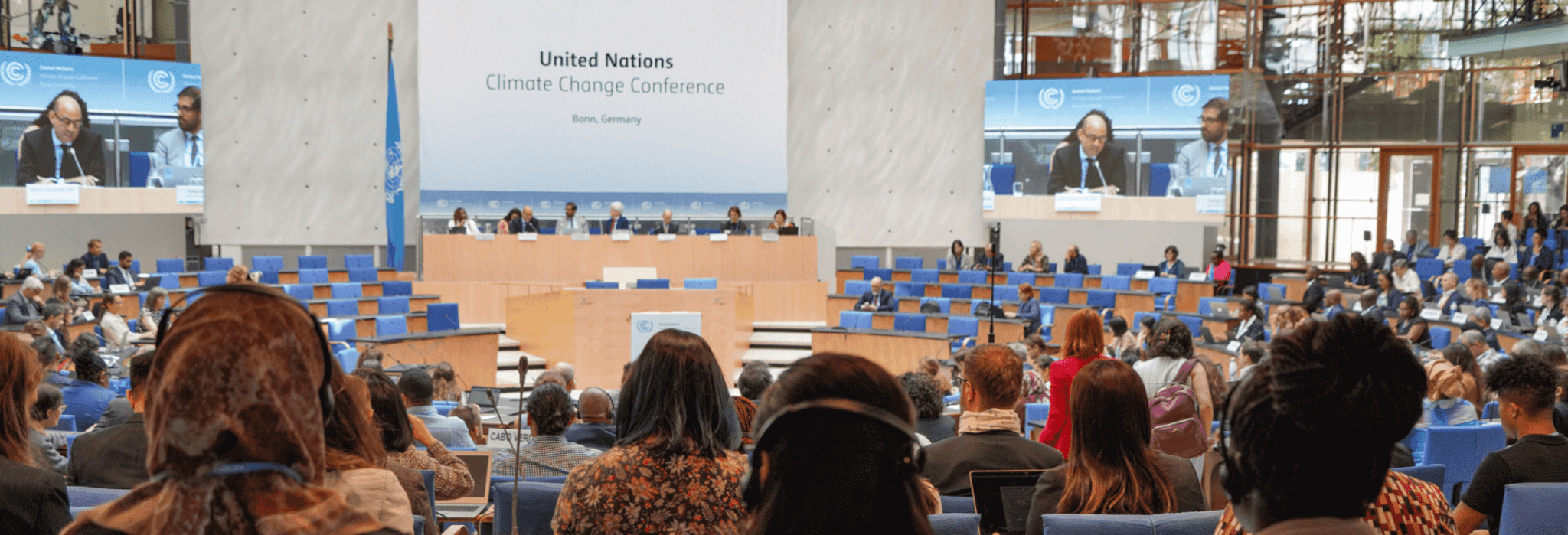
Last week, the United Nations Framework Convention on Climate Change (UNFCCC) published the Technical Synthesis Report for the world’s first Global Stocktake. This report is a milestone for assessing global progress on climate eight years after the Paris Agreement, paving the way for one of the most critical accountability moments for climate to date come December at COP28. World leaders must now take the results from this report and translate them into bolder and transformative action to cut emissions, build resilience, and boost climate finance.
“The Global Stocktake report stands as a candid reflection of our current climate crisis — leaving no room for excuses or delays,” said Jamal Srouji at the World Resources Institute. “Countries, cities, CEOs, and communities must rise to the occasion and build upon the foundation laid by the Stocktake.”
iGST’s Topline Takeaways
The Technical Synthesis Report identifies the course corrections needed to get climate action on track and avoid the worst outcomes of climate change. In order to execute this pivot, governments must now take the findings from this report and respond with ambitious new climate commitments at COP28.
“How well are we doing? Not well at all – the science makes this clear, as do the fires and the storms. And is the stocktake delivering results that help us do better?” said Tom Athanasiou at EcoEquity. “We’ll see soon, for with today’s report the technical phase of the first Global Stocktake is complete, and the ball has been handed to the world’s governments for the political phase. The question now is if they’re going to rise to the occasion.”
Our partners have outlined what the world can do next to ensure COP28 deliberations result in a clear and ambitious roadmap for course-correction. Chief among their reflections on the Technical Synthesis Report are:
- The need for governments to rise to the occasion and use COP28 to launch a coordinated response with commitments to reduce emissions, increase resilience to the impacts of climate change, and adequately finance the transition.
- The need for the private sector to scale investments aimed at ending fossil fuel use, building clean energy capacity, and protecting and preserving our natural environment.
- The need for the world to recognize this pivotal climate milestone as an opportunity to reinvigorate the spirit of globally coordinated, equitable, and intersectional climate action.
Topline findings in line with the goals of the Paris Agreement – and the five priority areas identified by the independent Global Stocktake (iGST) – include:
Adaptation
As we see increasing temperatures and accelerating natural disasters, more adaptation is “urgently needed…particularly for those who are least prepared for change and least able to recover from disasters.” However, existing adaptation plans are “fragmented, incremental, sector-specific and unequally distributed across regions,” and funding and support must be “rapidly scaled up” to meet adaptation and loss and damage needs.
Key adaptation takeaways from the report include:
- Funding and other support for adaptation and loss and damage, including innovative and novel sources of finance, must be rapidly scaled up to meet the urgent and increasing needs.
- Actions to increase adaptation and avert and minimize loss and damage must be enhanced, particularly in countries that are most vulnerable and least able to recover from climate events.
- Adaptation plans must be tailored to local contexts, populations, and priorities.
- Transparent reporting on adaptation is needed to help actors understand, implement, and cooperate on their adaptation strategies.
Finance
The effective deployment of at-scale finance, particularly in low-income countries, requires holistic reform, including scaled up public finance and regulatory shifts to redirect private finance toward climate solutions.
“We have to grasp the opportunity in the Global Stocktake to look at the financing of climate action holistically,” stated Charlene Watson at ODI. “We must use the Stocktake to send strong messages to the actors that shape these flows, whether public or private and domestic or international, or we risk a mismatch between the mosaic of routes to finance mitigation, adaptation and loss and damage with the goals of the Paris Agreement.”
Key finance takeaways from the report include:
- International public finance needs to be rapidly scaled and strategically deployed to meet urgent needs.
- Systemic reform can unlock finance and investments for climate action in line with low-emission and climate-resilient development.
- Significant finance, including from public sources, continues to be directed toward high emission sectors. This must be efficiently shifted towards climate action at scale.
- Regulations and policies must be in place to incentivize investments that transform the global financial system.
Mitigation
Simply put, we are not currently on track to achieve the temperature goals of the Paris Agreement, even with perfect implementation of current Nationally Determined Contributions. Parties must act urgently to course-correct, including scaling up renewables, phasing out fossil fuels, and engaging in systems transformations.
Key mitigation takeaways from the report include:
- The science is clear—we must urgently phase out unabated fossil fuels, scale up renewable energy, and protect and restore nature.
- We have proven and cost-effective technologies available today that can cut our emissions nearly in half by 2030.
- Countries must increase the ambition of their climate pledges while also doing more to ensure that the pledges are implemented through robust policy, adequate financing, and transparent reporting.
- Climate action is a job creator. In a just energy transition, 3.5 times more jobs could be created than lost by 2030. Mitigation approaches that also deliver sustainable development and a just transition can and should be prioritized across jurisdictions.
Equity
A focus on equity and inclusion will drive ambition in both climate action and support. Those most affected by climate impacts must be at the center of climate solutions.
“The Stocktake is crucial for climate-vulnerable countries in regions such as Southeast Asia to survive and thrive amid the climate crisis,” said Danica Marie Supnet at the Institute for Climate and Sustainable Cities. “Its outcomes can elevate accountability and put significant pressure on governments to enhance national targets in support of the Paris Agreement’s collective goals.”
Key equity takeaways from the report include:
- Equity is core to the Paris Agreement ambition and its urgency should be emphasized accordingly.
- The rapid and systemic transformations the climate emergency requires will have distributional impacts. Equity and inclusion are non-negotiable aspects of climate planning.
- Sustainable development and poverty alleviation should inform mitigation pathways.
- In line with their respective capacities and historic responsibilities, high-income countries must take the lead in providing public finance and support to underpin climate transitions.
- While the Global Stocktake is a Party-driven process, non-Party stakeholders including Indigenous peoples, local communities, and civil society representing communities often left out in climate action, such as women and youth, are critical to strengthening climate responses.
Implementation
There is a clear need for urgent action and support to accelerate implementation across all sectors and systems, in order to make progress towards the Paris Agreement and rapidly respond to the climate crisis.
Key implementation takeaways from the report include:
- Accountability and transparency mechanisms, including opportunities to learn from transparent reporting on progress and lessons learned, are core to implementation and should be prioritized alongside other climate action.
- Clean technologies need to be rapidly deployed and the innovation, development, and sharing of new technologies is core to supporting developing countries.
- Systems transformations are needed across sectors and contexts to achieve net zero, including:
- Scaling renewable energy
- Phasing out all unabated fossil fuels
- Halting deforestation
- Reducing harmful emissions beyond CO2
- Implementing measures to decarbonize both the supply and demand side of economies
As we now look to the conclusion of the first Global Stocktake, with countries deciding on their collective response plan at COP28, we urge leaders to take bold and brave actions in line with the urgency this moment demands.
“The outcome of the first Global Stocktake serves as a roadmap for climate action in this critical decade and beyond,” said Akibi Tsukui with the Institute for Global Environmental Strategies.“Non-state actors are the ones who implement this roadmap on the ground, standing ready to collaborate with governments who update and enhance their Nationally Determined Contributions.”
What’s Next in the Stocktake Process?
It is paramount that leaders take this opportunity for course-correction. While the technical report outlines the depth of shifts needed to achieve a climate-safe future, the Stocktake’s third and final phase will serve as a platform for countries to designate a collaborative path forward. Leaders should make appropriate preparations in line with this ambition to maximize the opportunity of COP28 as a catalytic moment in the global response to climate change.
“The Global Stocktake report reaffirms that we need strong country-level commitments to curb emissions and implement adaptation measures while allowing every global citizen the chance to improve their lives in a rapidly changing climate,” said Mohau Mateyisi at the Council for Scientific and Industrial Research.
iGST member organizations call on world leaders to respond to the stark messages delivered in this first Global Stocktake, with decisive action at COP28 that guides us toward a safe and prosperous future for all. Learn more about the Global Stocktake here and iGST’s recommendations for priority actions at COP28, here.

